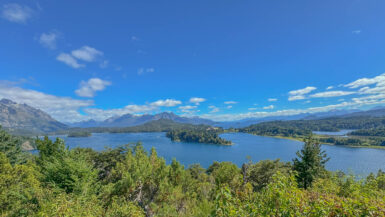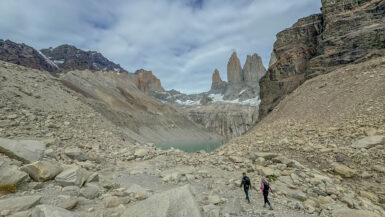After a full-day of adventures in Iquitos (Peru), my son and I woke up the next morning with the realization that the most adventurous part of our trip was just beginning. We were about to face four days and three nights in the Peruvian Amazon jungle, with the goal of seeing lots of birds (my goal) and snakes (my son’s goal … unfortunately). We’d arranged for a private guide who would take us on wildlife excursions during the day and at night. My son and I assumed this would involve hiking along well-trodden trails through the jungle. We were wrong. It turned out to be MUCH more adventurous then either of us anticipated, as you’ll see in the rest of this blog post.
Table of Contents
The boat from Iquitos, Peru to the Otorongo Amazon River Lodge
After an early breakfast, we were picked up by our guide and whisked away in a tuk-tuk through narrow alleys in Iquitos until we found ourselves at the end of the road. This is where our boat awaited to take us to the jungle.
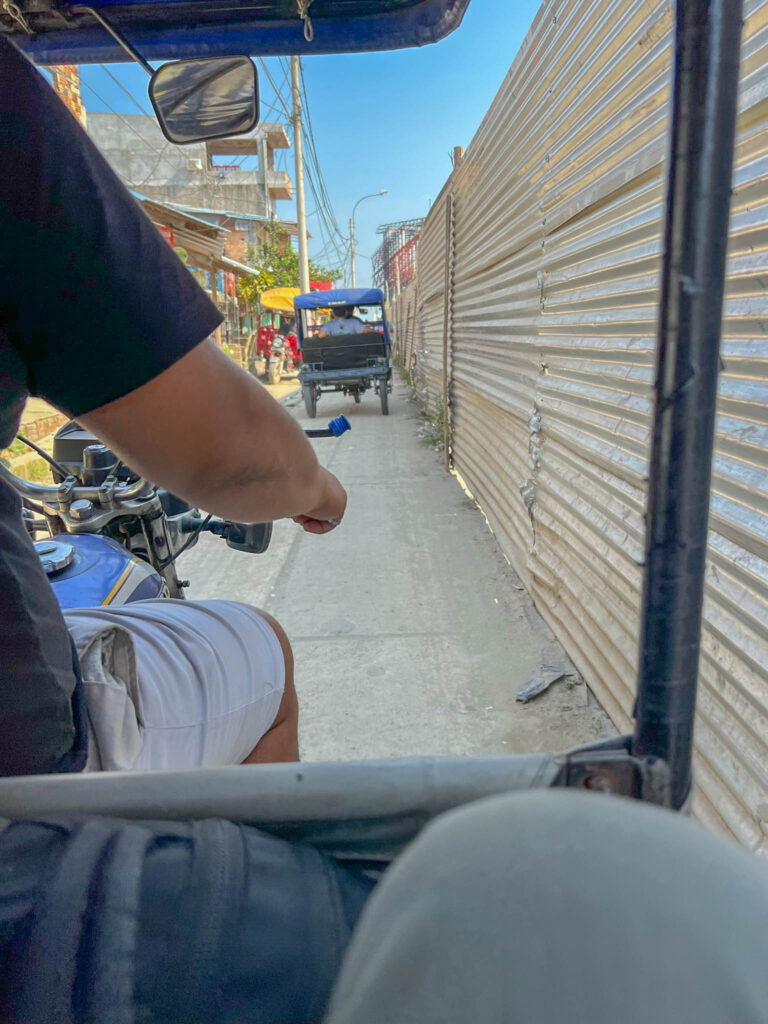
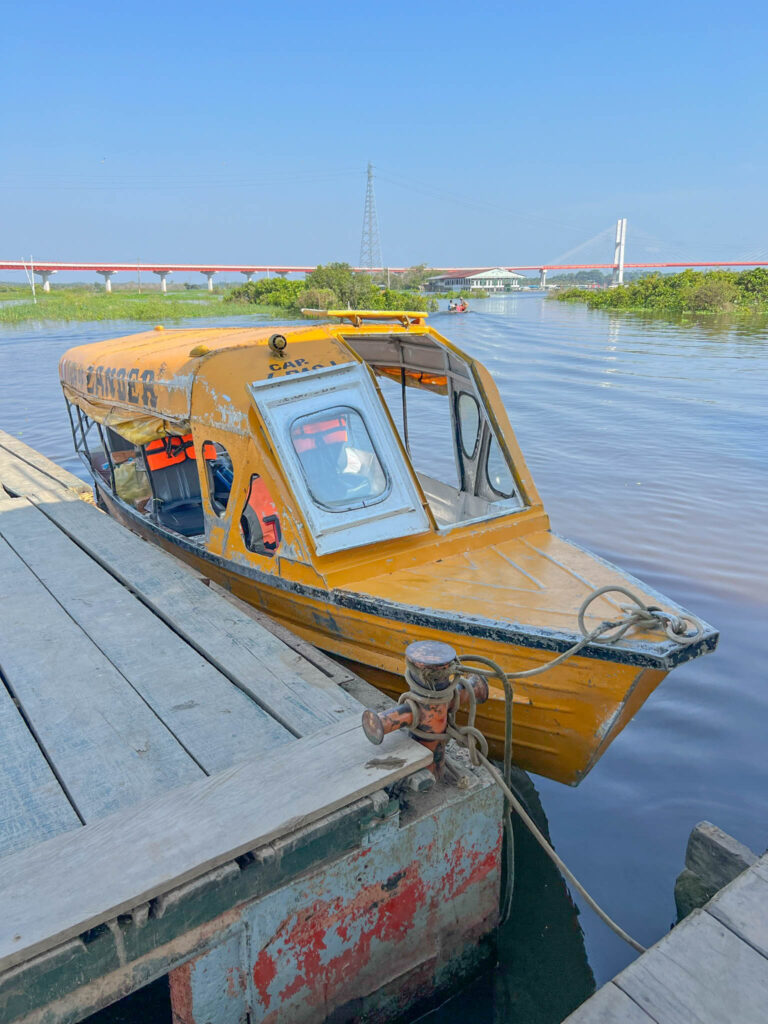
There were no other people on the boat. It was just me, my son, our guide, and the boat captain … and a small colony of baby spiders. I mention the spiders because they were situated close to the captain’s head. As we picked up speed, the spiders ballooned one-by-one directly towards my son. Thankfully, my seat was out of the path of the flying spiders. But it gave me front row seats to be entertained by my son’s spontaneous bouts of shadow boxing. At least that is what it must have looked like to our guide, who was seated behind us.
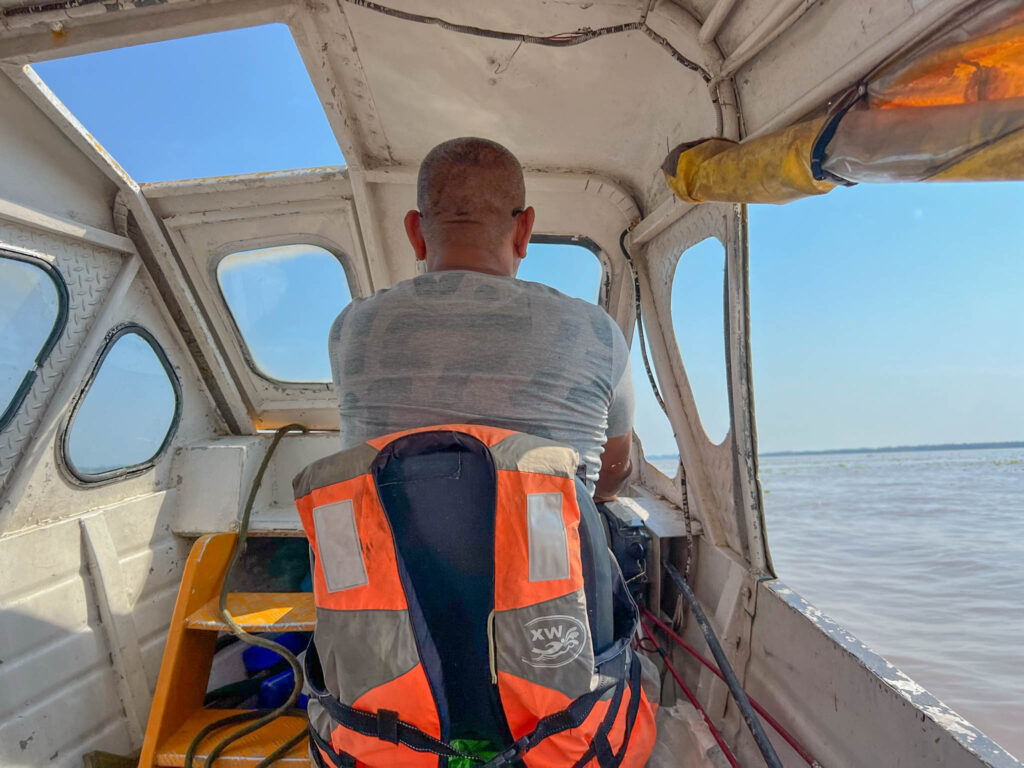
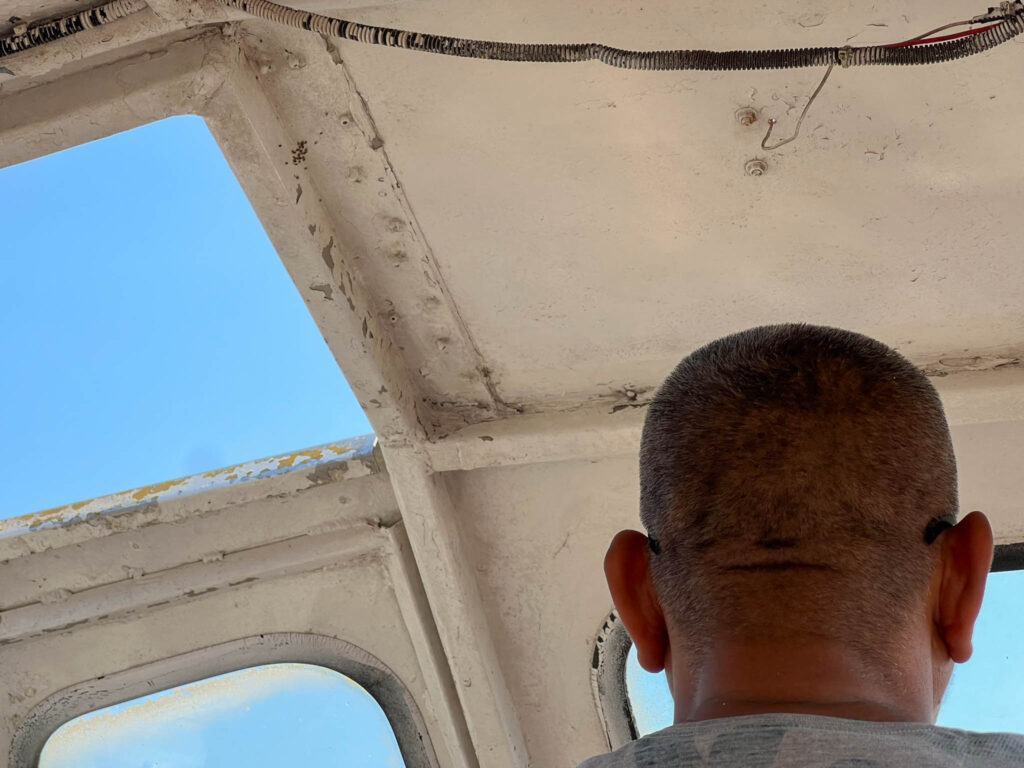
The ~100km river journey from Iquitos to the Otorongo Amazon River Lodge took about 2.5 hours to complete. It takes about an hour longer on the return to Iquitos since that leg of the journey is upstream. By the time we arrived, there were no more spiders near our captain’s head, but quite a few near my son’s feet.
Welcome to Otorongo Amazon River Lodge
One of the first things we noticed upon arriving at Otorongo Amazon River Lodge is that we appeared to be the only ones there. Our guide confirmed that the recent events in Peru had impacted tourism. Protests in the country resulted in the closure of Machu Picchu, so many visitors to Peru decided to cancel or postpone their trip. Since our only destination in Peru was the Amazon, we kept our plans and were glad that we did. We had no issues at all during our trip since we were far from the areas of unrest. While I felt bad for the lodge, we were thrilled to have the place to ourselves.
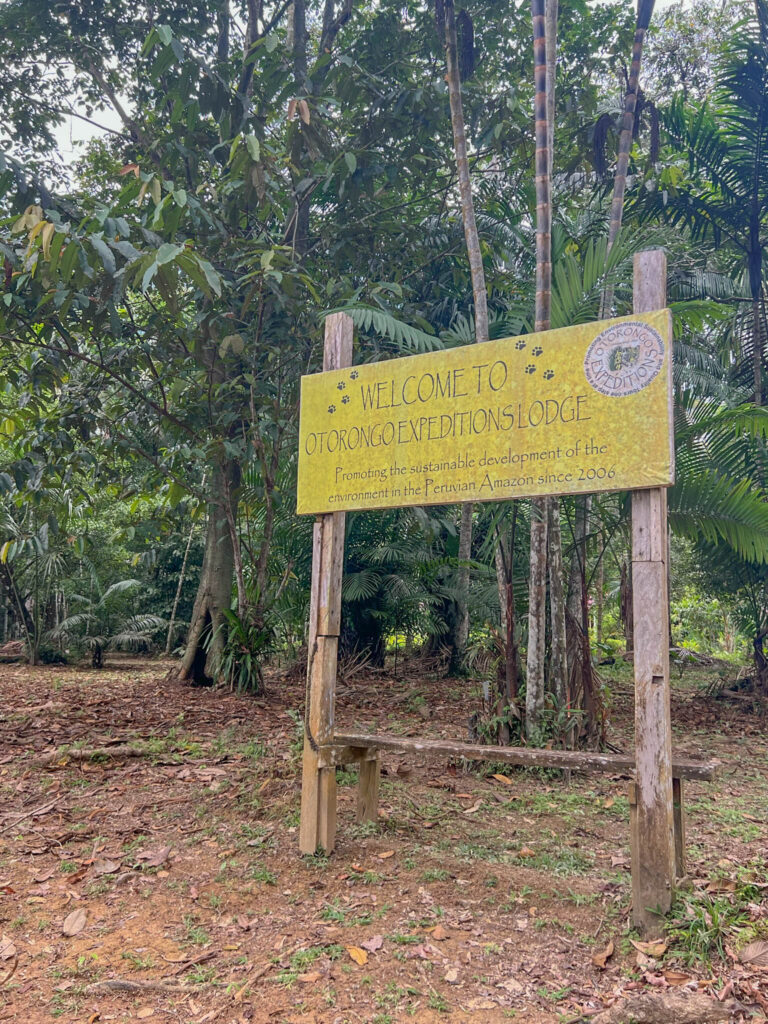
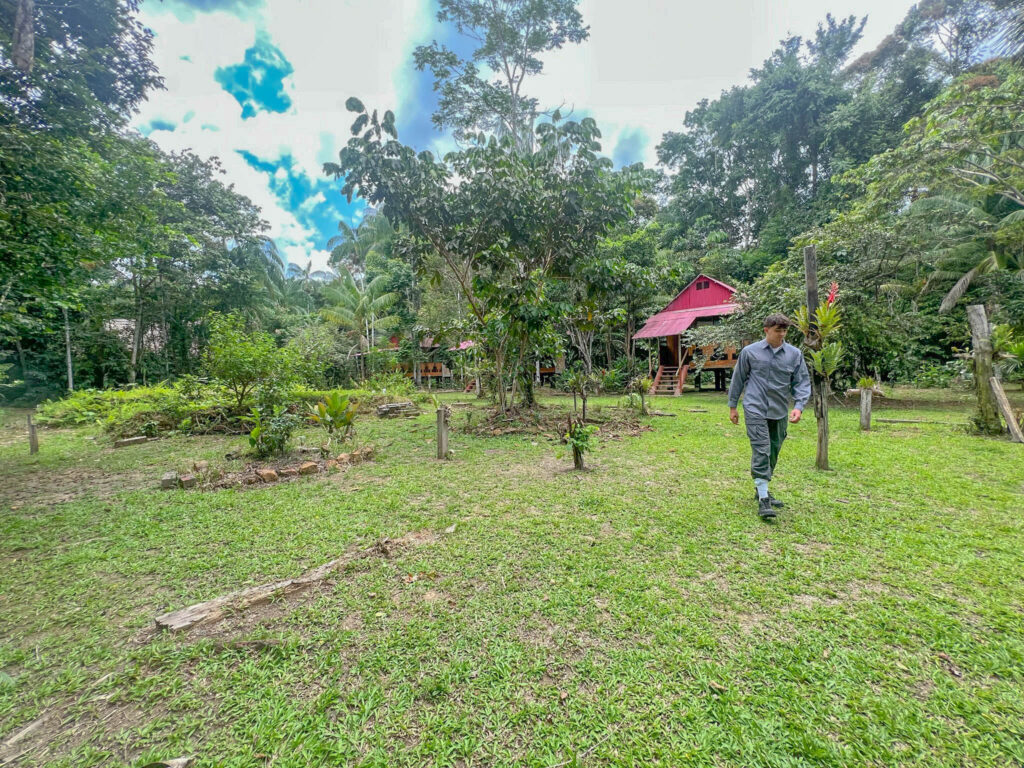
Our accommodation consisted of an above-ground cabin with screen windows. There’s no air conditioning or hot water at the Lodge. There was also no phone reception, Wi-Fi, or TV, so we were completely cut off from the world for 4 days, which was a nice change. However, our room did have a solar powered light and outlet to charge electronics. Our only entertainment was soaking in the sights and sounds of the jungle, which was far from boring.

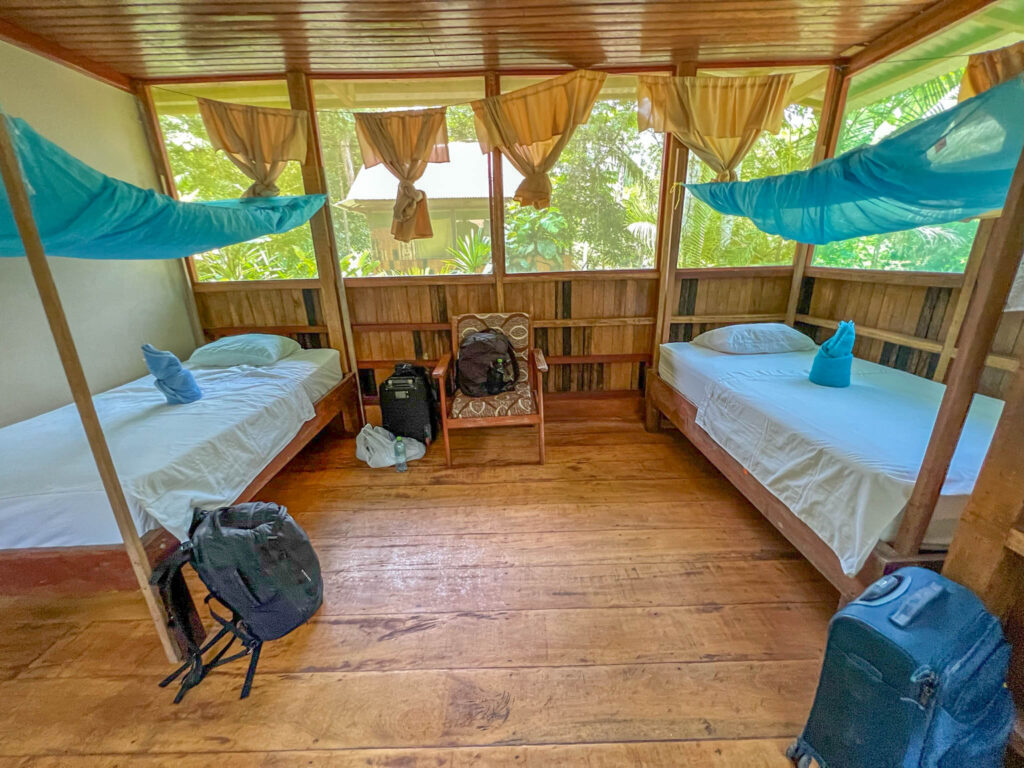
In addition to our cabin, there’s also a “hammock room” for lodge guests. Since we were the only guests, it served as our own private hammock room during our stay, which we took full advantage during our breaks between the energy draining excursions in the heat. The highs consistently ranged from 89 – 92 and the lows were 71-73, with high humidity. Needless to say, we were sweating … a lot.
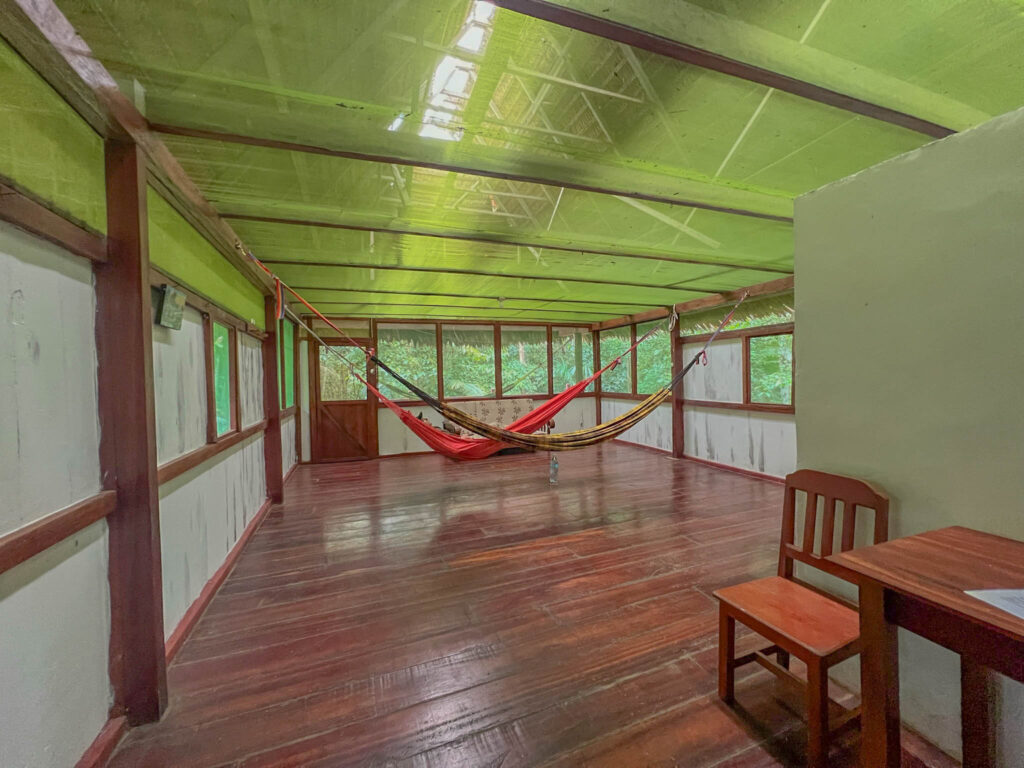
Daytime excursions in the jungle
When researching amazon jungle lodges in Peru and Ecuador, I selected Otorongo Amazon River Lodge for several reasons. At the top of the list was the fact that we would have our own private guides who specialized in birds and reptiles. Second, the prices were reasonable, since it’s not a fancy resort. Otorongo Lodge is comfortable but with no frills. The focus is on wildlife observation and having a full-immersion jungle experience. Finally, it was also highly rated, so that sealed the deal.
We were assigned two guides. Our main guide, Eddie, was a fount of knowledge about the animals and plants in the jungle and an expert at identifying birds by sight and sound. Our second guide, “Mike”, was a local who led the way as we navigated the jungle and narrow tributaries since he knew the area like the back of his hand. We called him “machete Mike” because he always carried a machete as we bushwhacked off trail in search of snakes and other animals.
Before I say more about our excursions, I should explain that our experience was not the norm. In talking with Eddie, he learned that I was a former conservation biologist and my son demonstrated his encyclopedic knowledge of snakes. As a result, Eddie and machete Mike treated us very differently. We had experiences that are more typical of professional herpetology and field biology expeditions that visit the area, rather than a typical tourist experience. These excursions were amazing, and they pushed us well beyond our comfort zone at times … but in a good way.
Our daytime excursions started with an early morning breakfast (around 6am) followed by several hours of birding. We spent the afternoons and evenings looking for snakes and other reptiles. Of course, we were always on the lookout for mammals and insects too.
Birding
A lot of the birding trips were done via boat. Our canoe had a small engine to take us to birding hot spots. Once we arrived, our guides switched to paddles so that we could quietly observe and listen to the amazing abundance of bird species. My son and I enjoyed hearing the unusual sound of the russet-backed oropendola each day, and passing by a small cliff that was home to at least three species of kingfishers (Amazon kingfisher, Ringed kingfisher, and Green kingfisher). Even walking around our lodge, we commonly saw scarlet macaws, parakeets, and parrots … and they weren’t in birdcages.
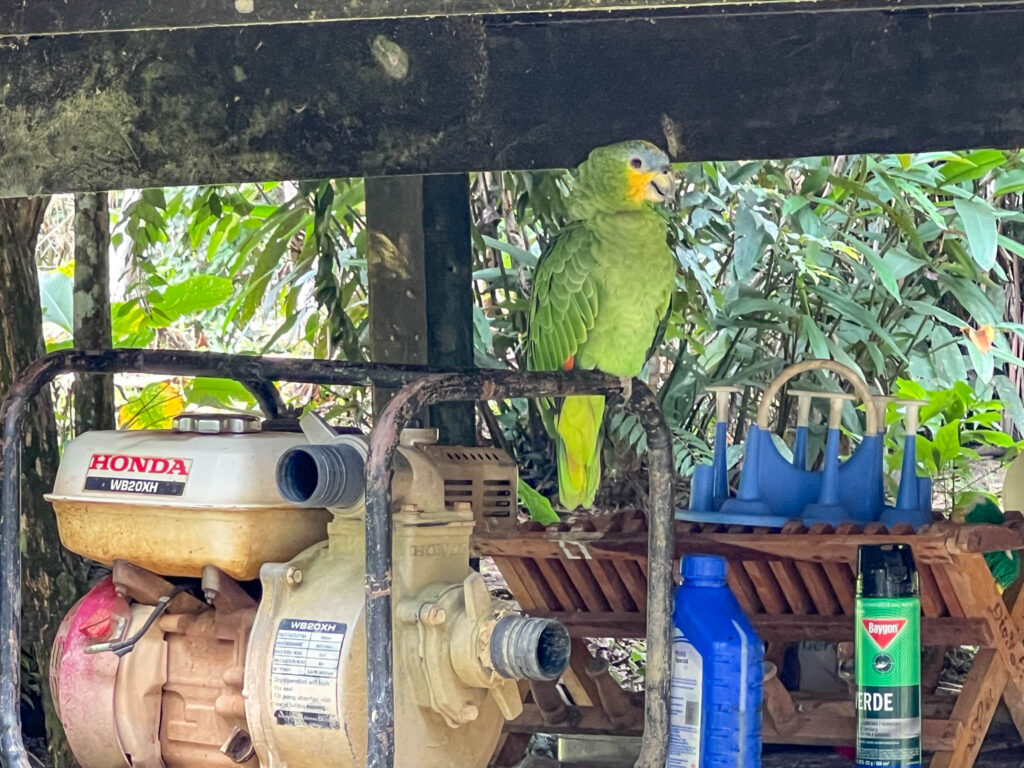
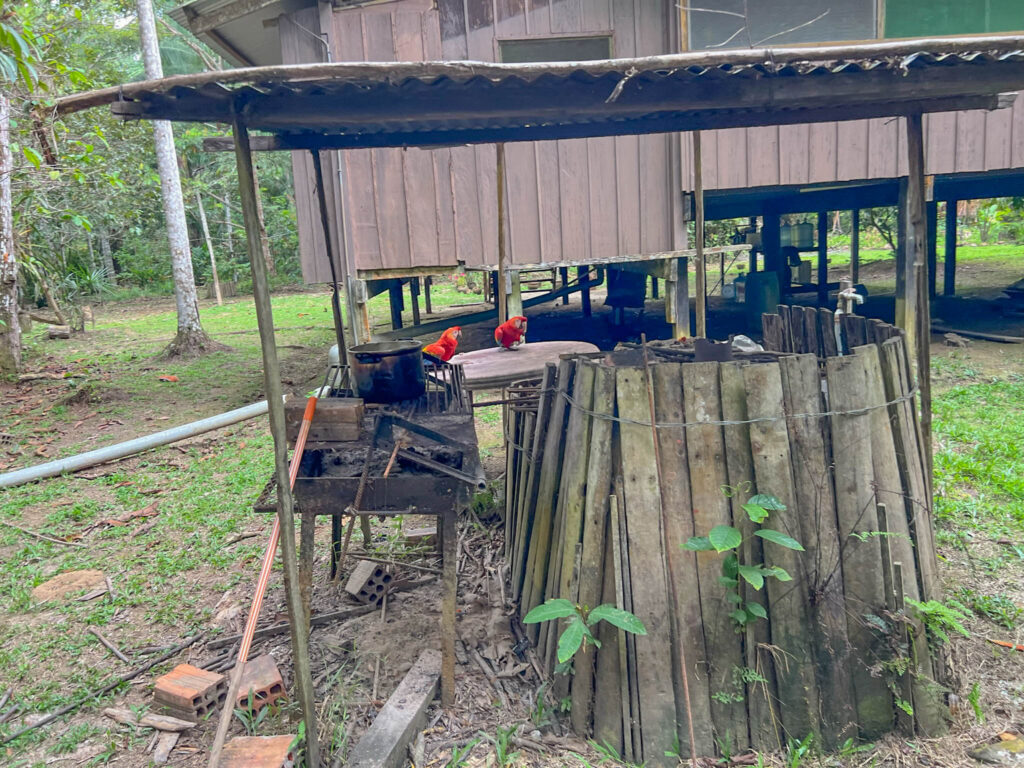

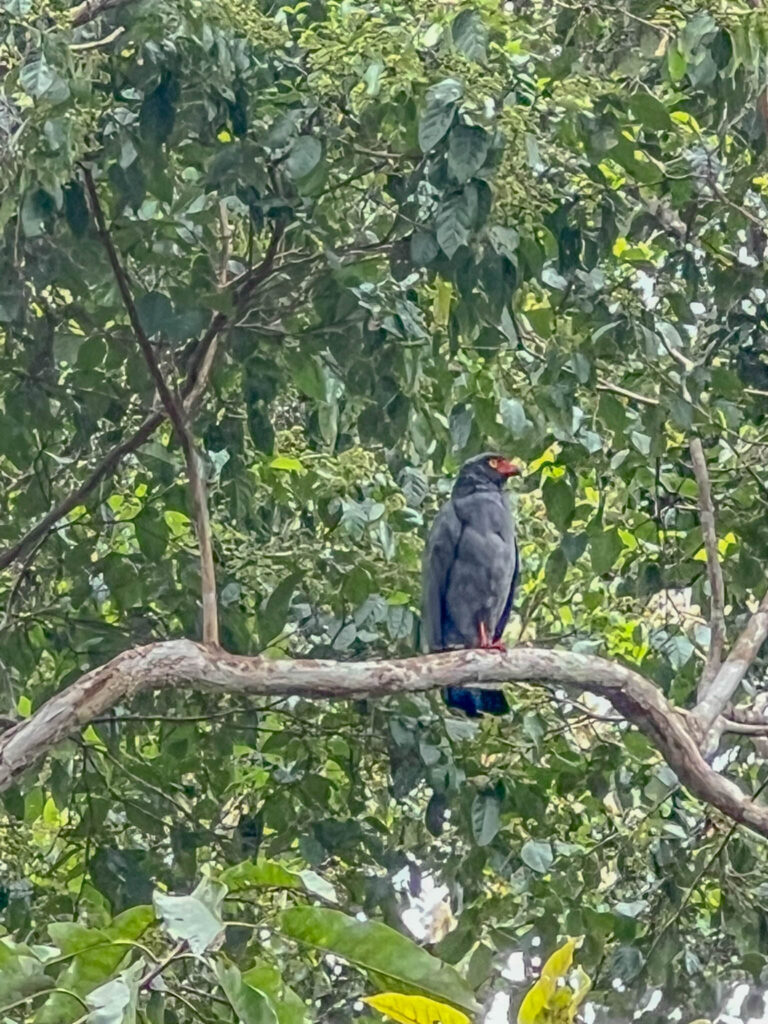
We ended up seeing a total of 130 bird species, many of which I’ve never heard of, let alone seen. Needless to say, I would’ve only been able to identify a tiny fraction of that number if I was on my own. Our guides were amazing. Given that there are 400 – 500 bird species in this area, we only scratched the surface. To make your eyes glaze over, here are the species we encountered:
- Agami Heron
- Amazon Kingfisher
- American Pygmy Kingfisher
- Bananaquit
- Barn Swallow
- Barred Antshrike
- Black Vulture
- Black-capped Donacobius
- Black-chinned Antbird
- Black-collared Hawk
- Black-crowned Night-Heron
- Black-faced Antbird
- Black-fronted Nunbird
- Black-tailed Tityra
- Black-tailed Trogon
- Blue-gray Tanager
- Blue-headed Parrot
- Bluish-gray Saltator
- Boat-billed Flycatcher
- Bright-rumped Attila
- Buff-breasted Wren
- Buff-throated Woodcreeper
- Capped Heron
- Chestnut-bellied Seedeater
- Chestnut-eared Aracari
- Chivi Vireo
- Cinereous Tinamou
- Cocoi Heron
- Common Pauraque
- Coraya Wren
- Crimson-crested Woodpecker
- Dark-breasted Spinetail
- Drab Water Tyrant
- Dusky-headed Parakeet
- Fork-tailed Flycatcher
- Fork-tailed Palm Swift
- Glittering-throated Emerald
- Gray-capped Flycatcher
- Gray-crowned Flycatcher
- Gray-fronted Dove
- Great Antshrike
- Great Black Hawk
- Great Egret
- Great Kiskadee
- Greater Ani
- Greater Yellow-headed Vulture
- Green Kingfisher
- Green-and-rufous Kingfisher
- Hooded Tanager
- Horned Screamer
- Ladder-tailed Nightjar
- Large-billed Tern
- Lesser Kiskadee
- Lettered Aracari
- Limpkin
- Long-billed Woodcreeper
- Masked Crimson Tanager
- Muscovy Duck
- Neotropic Cormorant
- Olive-spotted Hummingbird
- Orange-backed Troupial
- Orange-winged Parrot
- Osprey
- Pale-vented Pigeon
- Palm Tanager
- Peruvian Warbling-Antbird
- Pied Lapwing
- Piratic Flycatcher
- Plain-crowned Spinetail
- Plumbeous Antbird
- Plumbeous Kite
- Plumbeous Pigeon
- Purple-throated Euphonia
- Purple-throated Fruitcrow
- Pygmy Antwren
- Red-and-white Spinetail
- Red-bellied Macaw
- Ringed Kingfisher
- Riparian Antbird
- Roadside Hawk
- Rock Pigeon
- Ruddy Pigeon
- Rufescent Tiger-Heron
- Russet-backed Oropendola
- Scarlet Macaw
- Scarlet-crowned Barbet
- Short-tailed Parrot
- Short-tailed Pygmy-Tyrant
- Silver-beaked Tanager
- Silvered Antbird
- Slate-colored Hawk
- Slender-billed Kite
- Slender-footed Tyrannulet
- Smooth-billed Ani
- Snowy Egret
- Social Flycatcher
- Southern Beardless-Tyrannulet
- Southern Rough-winged Swallow
- Speckled Chachalaca
- Spotted Tody-Flycatcher
- Squirrel Cuckoo
- Striated Heron
- Striped Woodcreeper
- Sungrebe
- Swainson’s Thrush
- Swallow-winged Puffbird
- Thrush-like Wren
- Tropical Kingbird
- Tropical Screech-Owl
- Turkey Vulture
- Turquoise Tanager
- Varzea Schiffornis
- Violaceous Jay
- Wattled Jacana
- White-banded Swallow
- White-bearded Hermit
- White-chinned Jacamar
- White-eared Jacamar
- White-eyed Parakeet
- White-shouldered Antbird
- White-throated Toucan
- White-vented Euphonia
- White-winged Becard
- White-winged Parakeet
- White-winged Swallow
- Yellow-billed Tern
- Yellow-browed Sparrow
- Yellow-crowned Tyrannulet
- Yellow-headed Caracara
- Yellow-rumped Cacique
- Yellow-tufted Woodpecker
Herping (Reptiles and Amphibians)
Whereas birding was a relaxing and enjoyable activity, herping was a very different experience. Herping is term used by herpetologists to describe the act of searching for amphibians or reptiles. This activity involved hiking off-trail and through water to explore places you normally don’t want to go. But it definitely keeps you alert! We walked through an electric eel pond (we were told that the eels will feel our vibrations and will move away from us), many mucky/mangrove swamp areas, and spent time in canoes paddling through low hanging branches that might be home to snakes. Thankfully, the lodge gave us rubber boots to use during our stay. Otherwise, our hiking shoes would’ve been trashed.
The most intense daytime herping trip involved spending a few hours in an area that is known to have many venomous snakes, such as the fer-de-lance and bushmaster, that blend in perfectly with the leaf litter that covers the ground. Those sweat-filled hours involved using a long stick to poke the ground in front of us before taking our next step. It felt similar to mountaineering where you test your next move with an ice axe before you commit to that move. It was pretty crazy. Even the guides traveled very slowly and carefully. We never did find a fer-de-lance, but our guide assured us that many fer-de-lance saw us.
Ok, time for a trigger alert! If pictures of snakes will upset or haunt you, then you’ll probably want to skip to the next section.
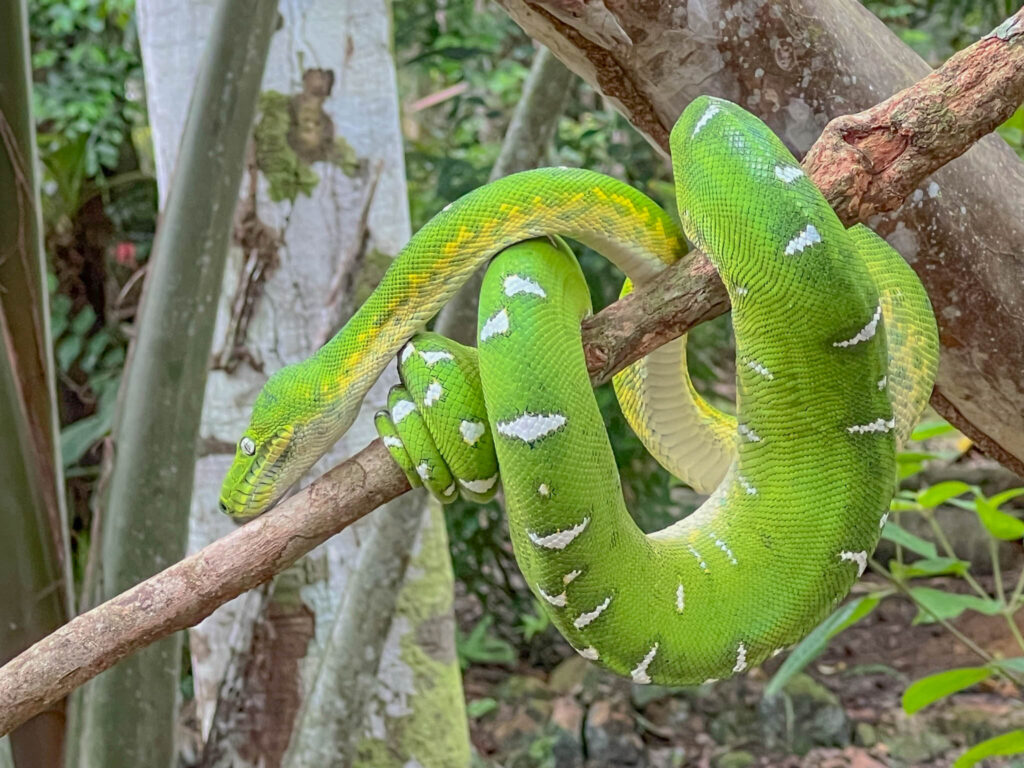
Erik tries to catch a feisty Amazon scarlet snake …
Our guide, Eddie, steps in to catch the Amazon scarlet snake but ends up doing it the hard way … by getting bitten. It’s a non-venomous snake so it doesn’t worry Eddie, as you can see in the video below.
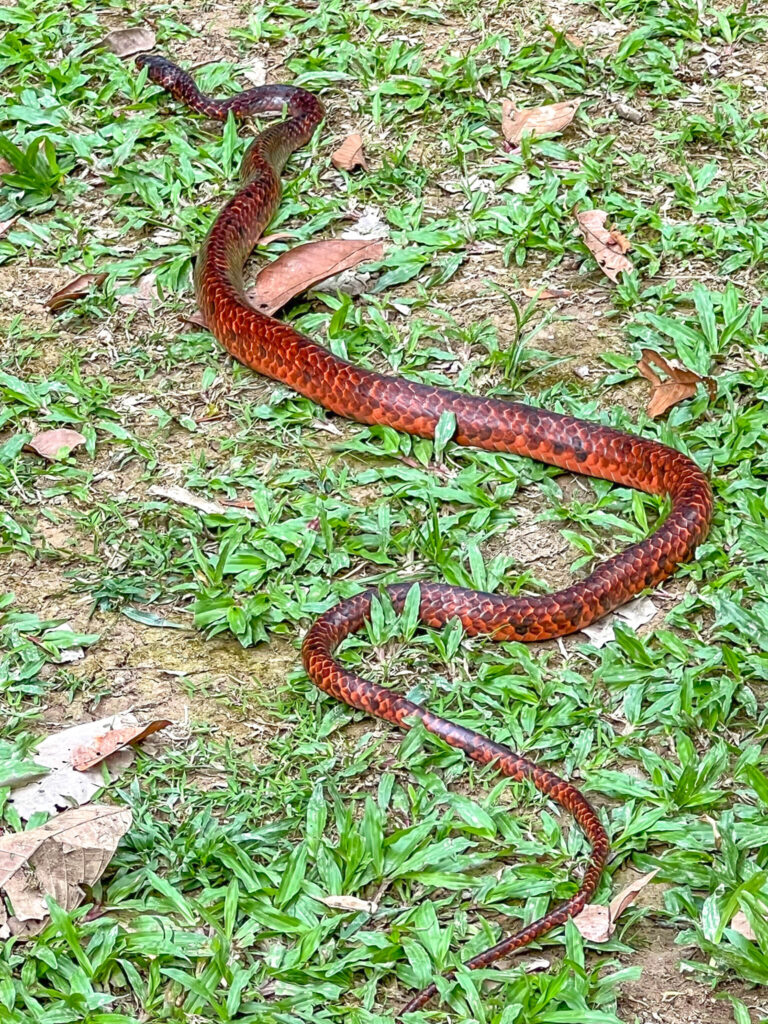
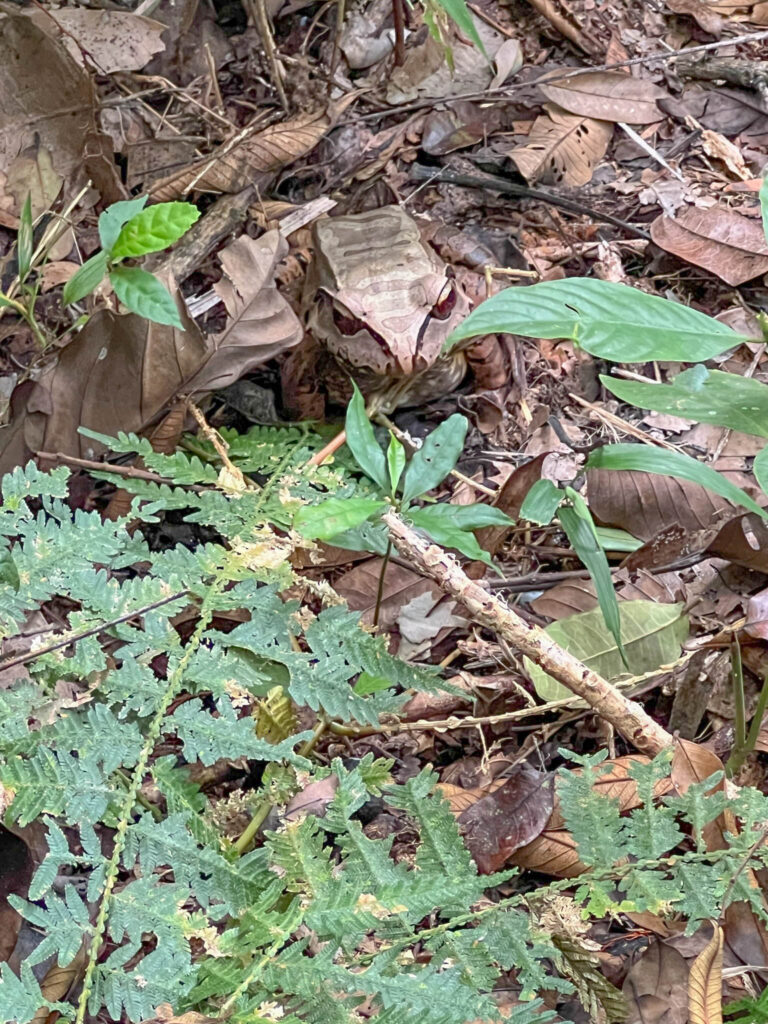
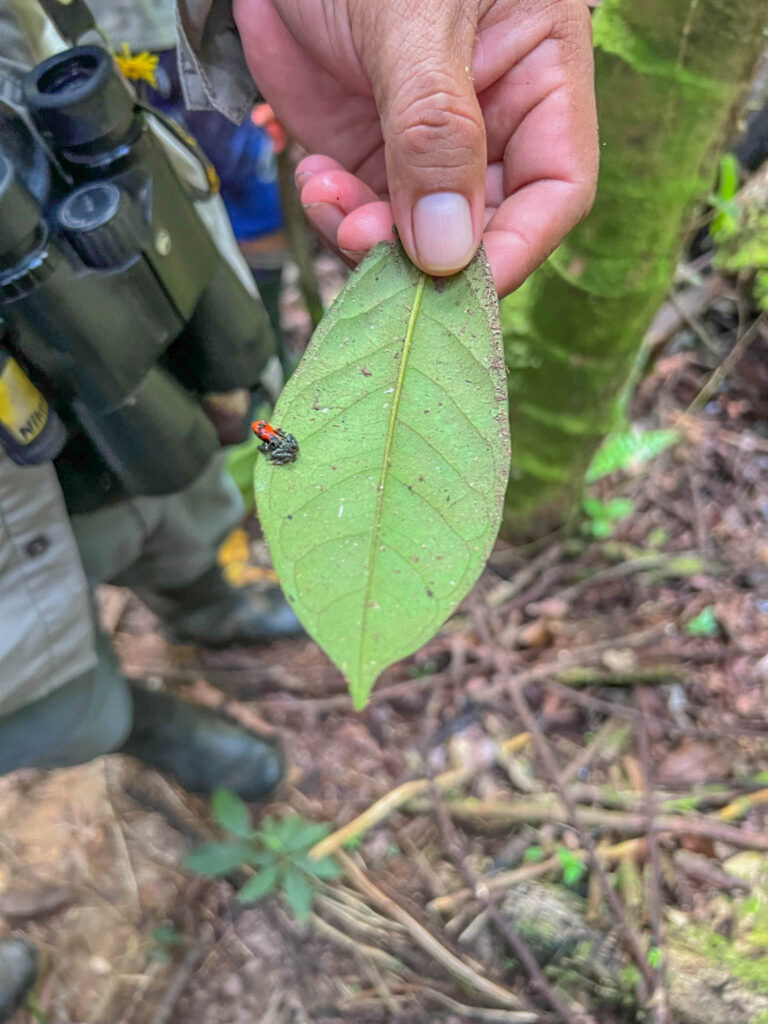
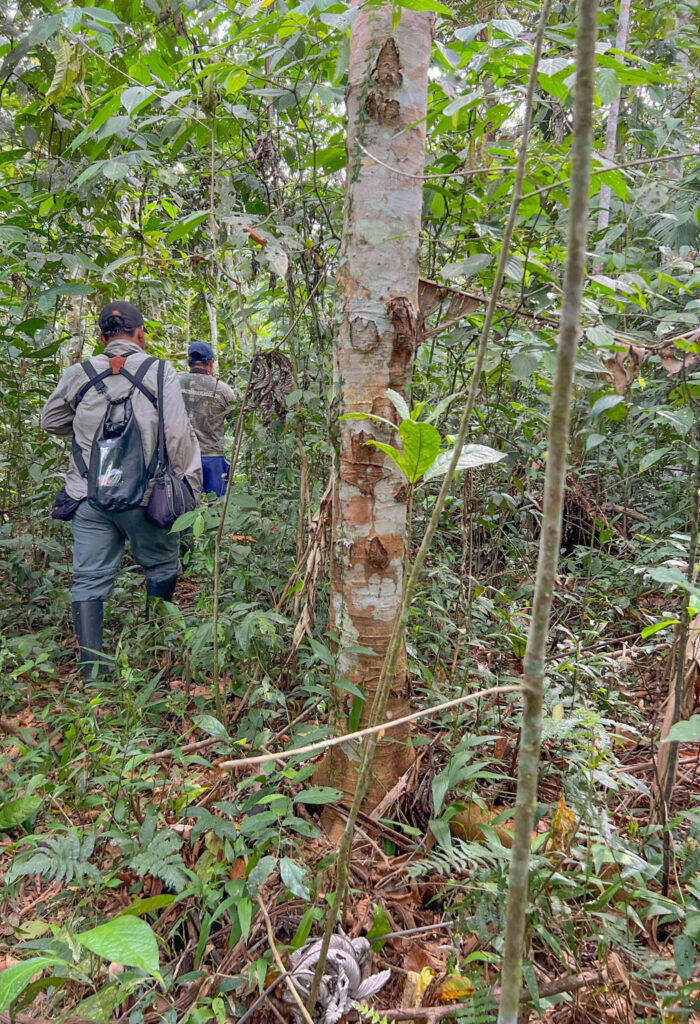
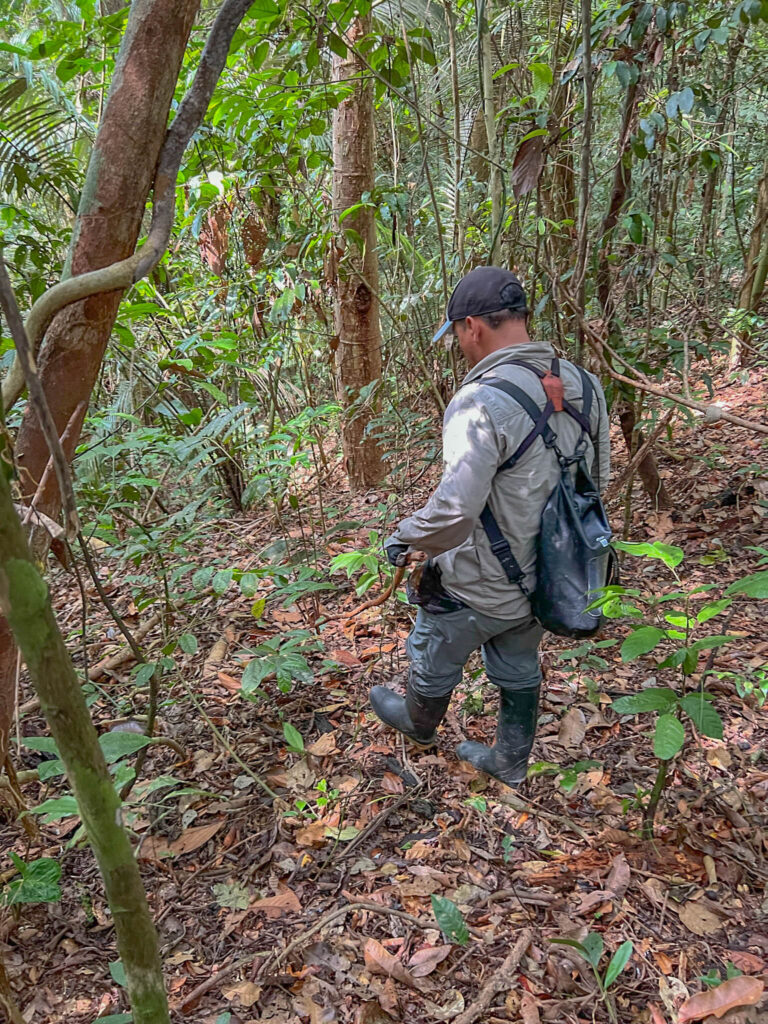
Piranha fishing
Another interesting daytime excursion was fishing for piranha. This involved taking the canoe into a known hotspot for piranha. We were each given a long stick that would serve as our fishing pole. A notch was cut into the top of the pole to accommodate fishing line. For bait, we were given chunks of meat to put on the hook. Finally, we plopped the bait into the water and deliberately made a series of small splashes with the tip of our fishing stick to simulate thrashing of piranha prey. It didn’t take long before we started catching fish, but it was mostly catfish. Funny enough, we learned that handling the catfish is more dangerous than handling piranha, thanks to sharp spines on the fins of catfish. Each of us caught catfish, but only machete Mike was able to catch a piranha. We kept one catfish and the one piranha to cook as part of our dinner that evening, and the rest of the fish were released back into the water.
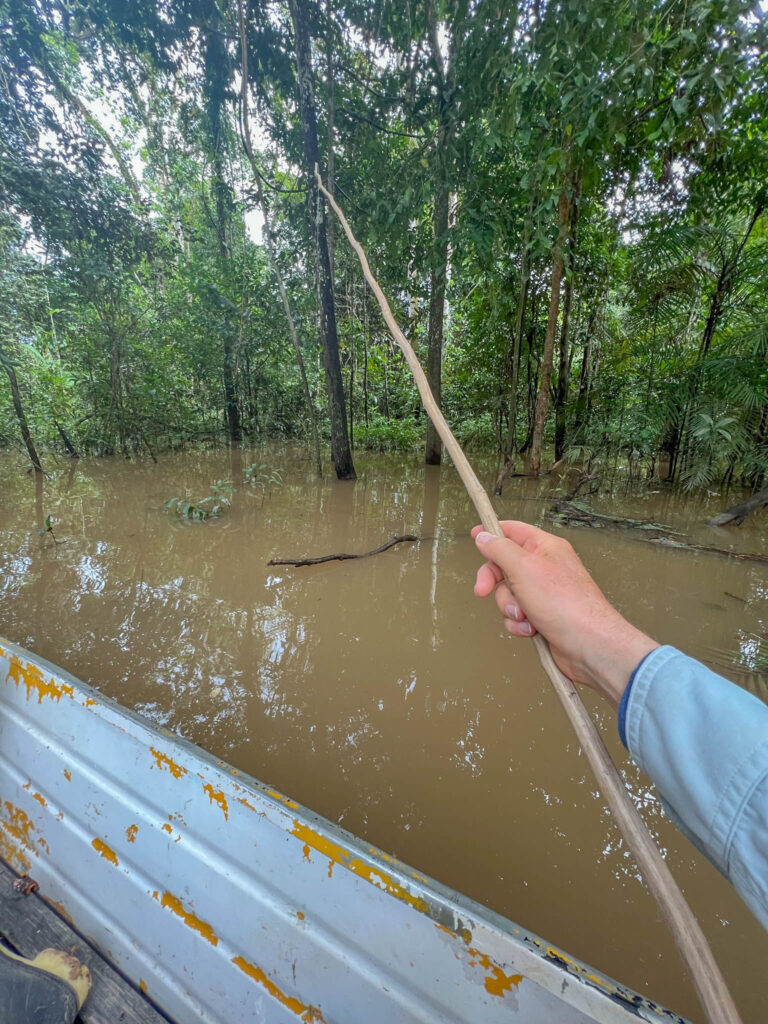
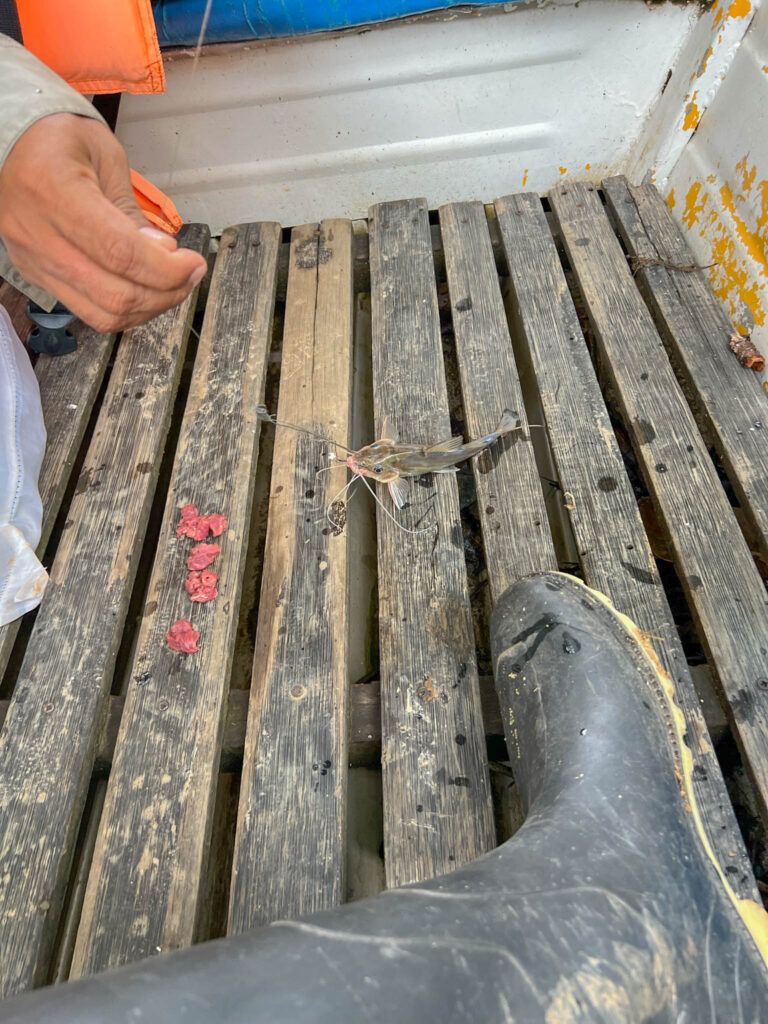
Fishing bait next to a catfish that was soon to be released back into the water
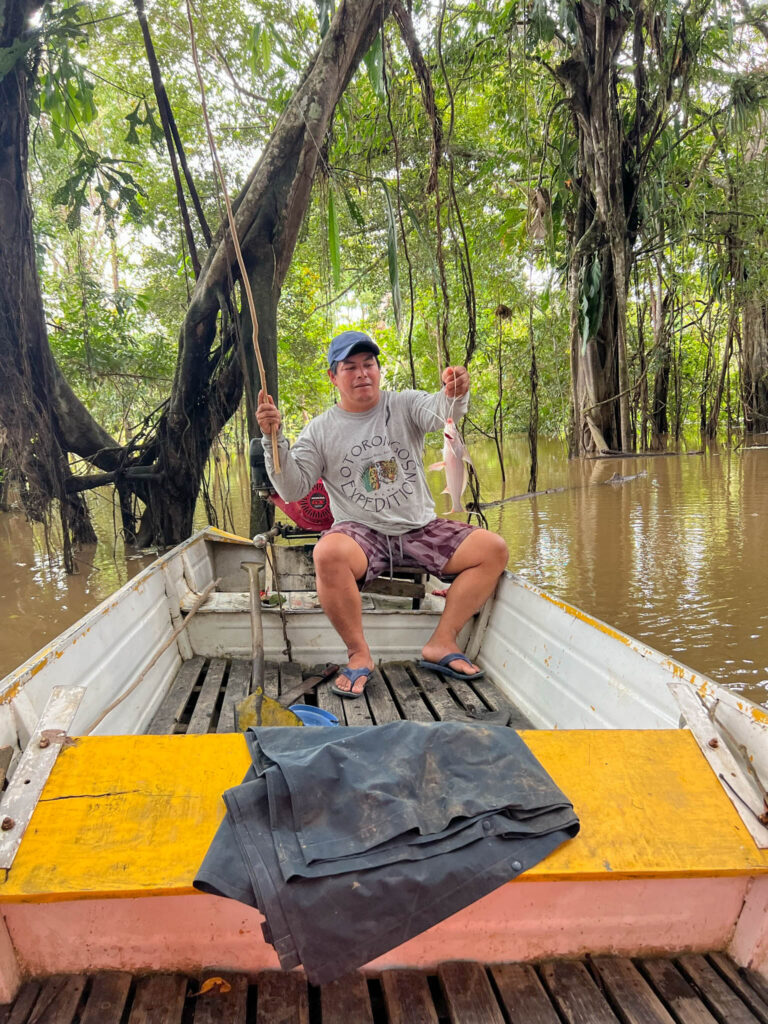
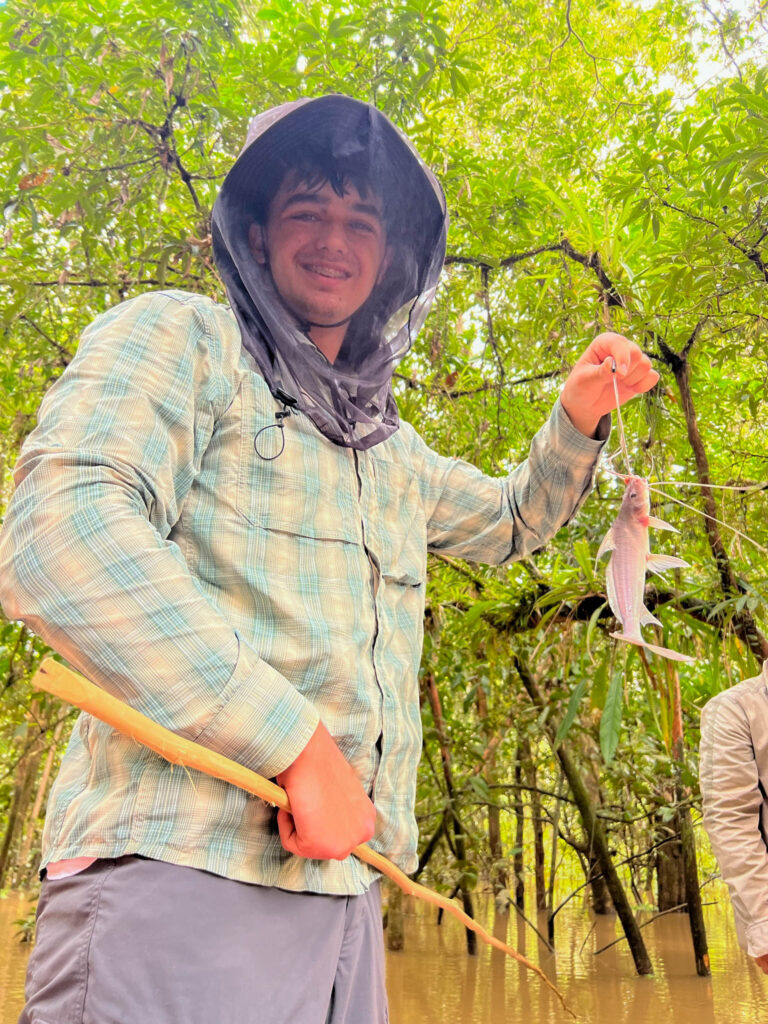
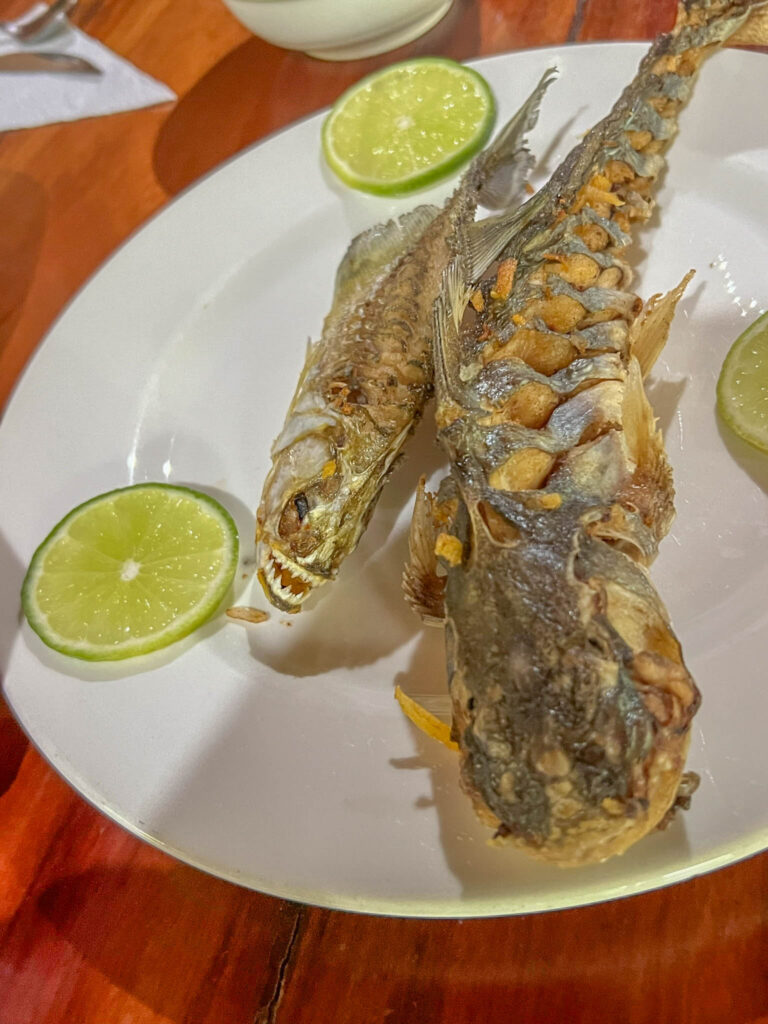
Mammals and insects
During our trip, we were always on the lookout for mammals. We came across 10 specie of mammals, including several monkeys (pygmy marmosets, black tamarins, black-mantled tamarin, white-tailed titi, and squirrel monkeys), a white-bellied slender opossum, fishing bats, gray dolphin, pink river dolphin, and three-toed sloth.
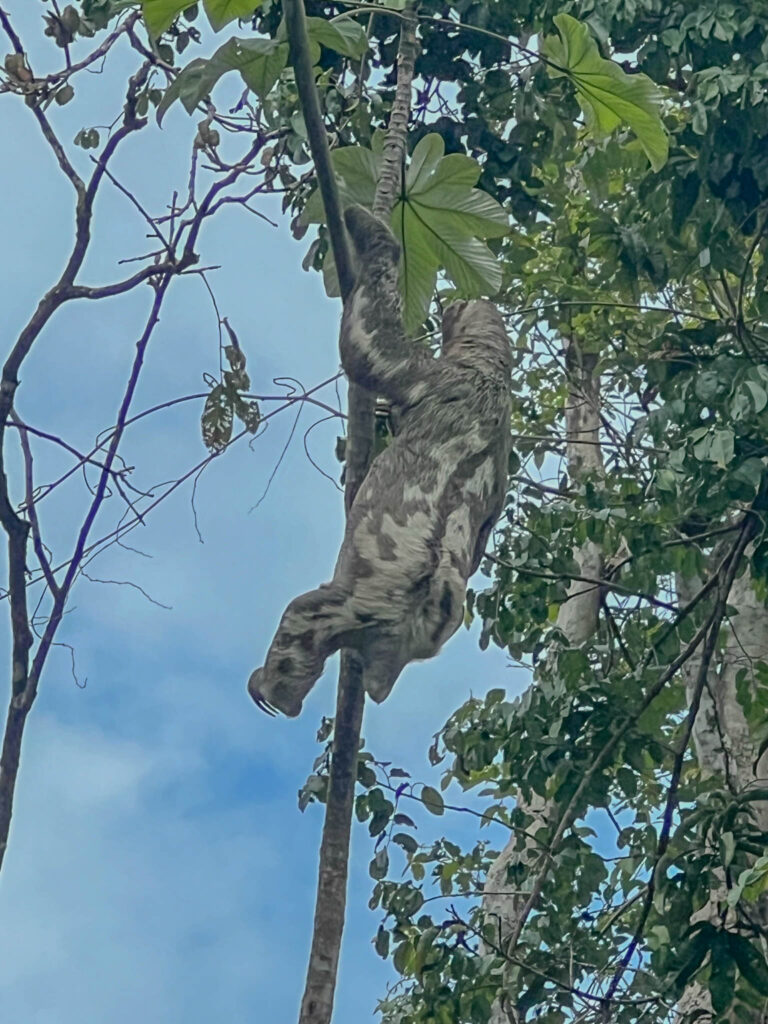
And then there’s the insects. As you can imagine, there’s no shortage of insects in the Amazon. They are literally everywhere. It’s amazing to see. Here are a few examples:
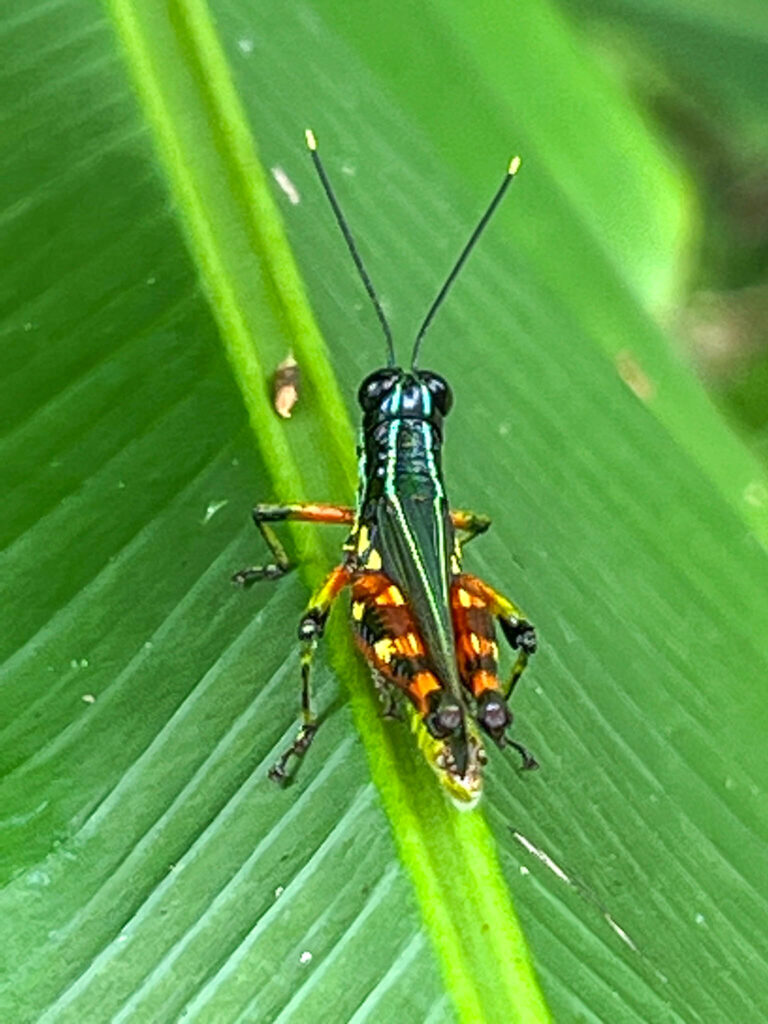

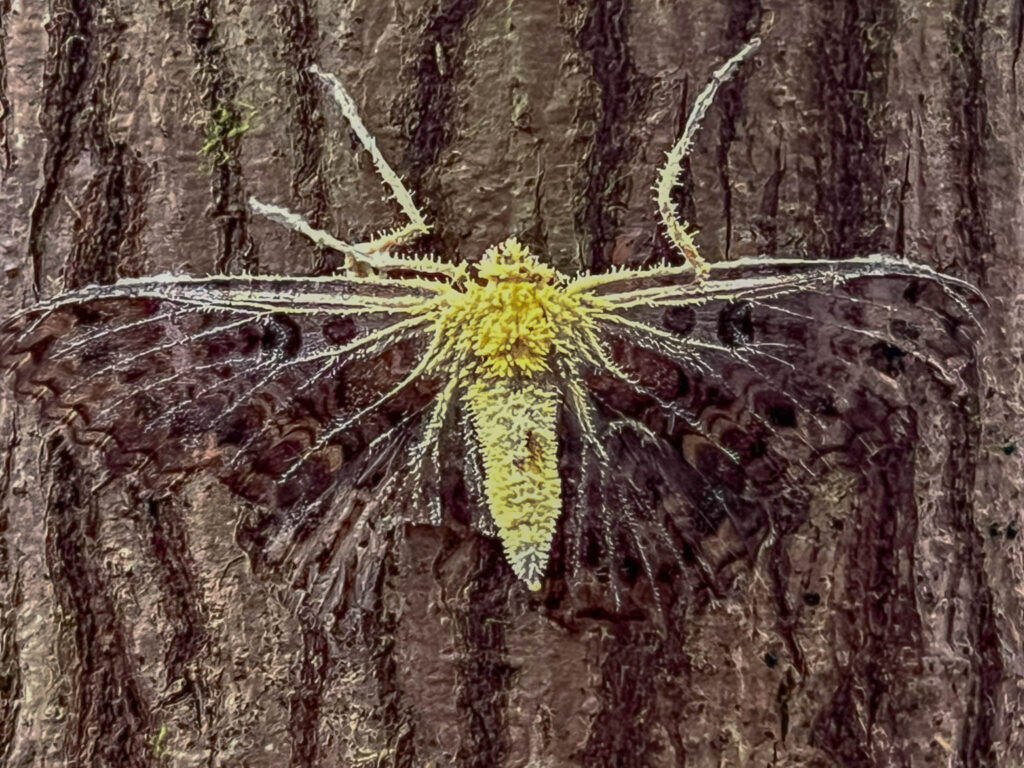
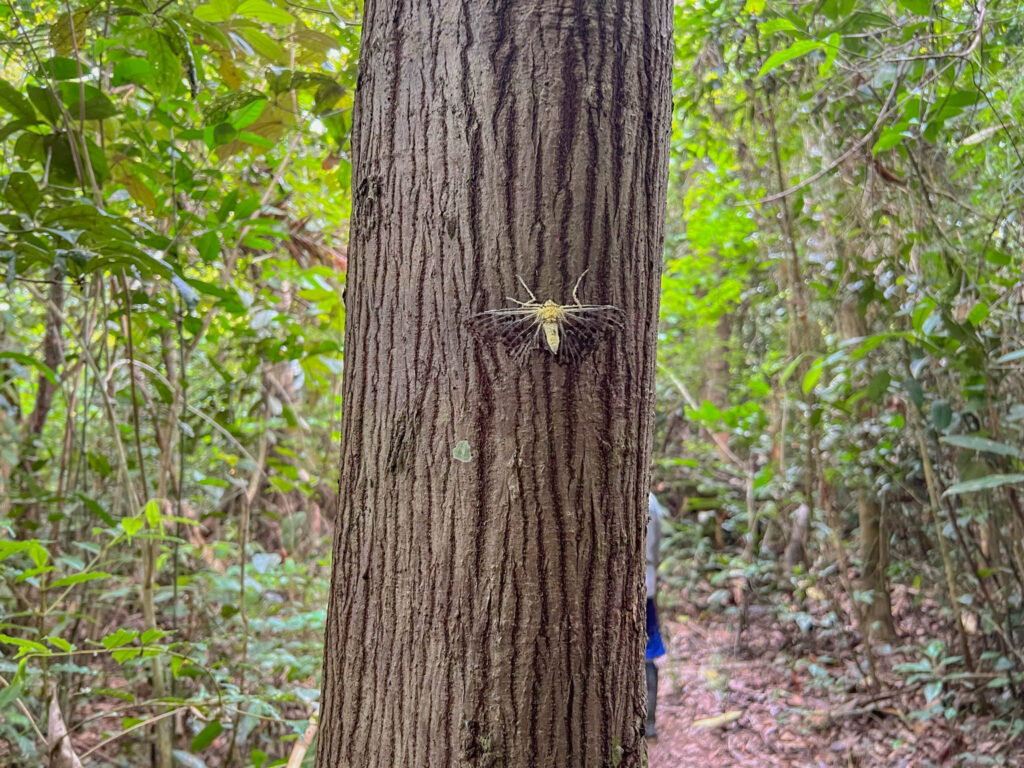
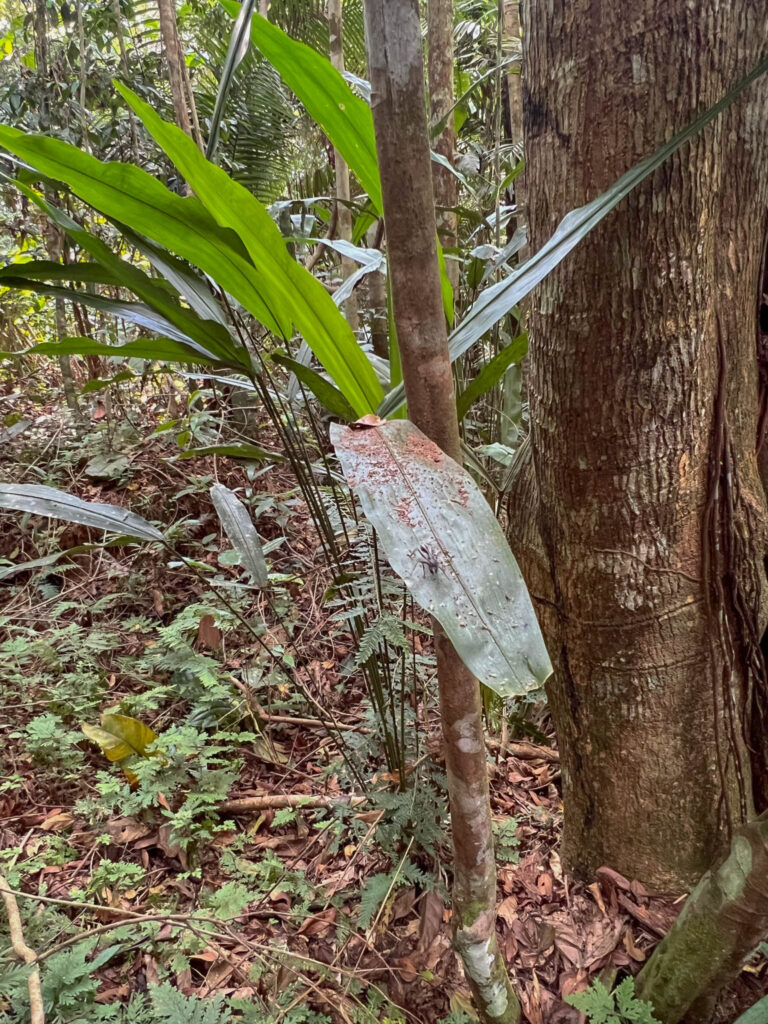
Nighttime excursions in the jungle
Herping at night
The nighttime herping excursions felt surreal at times. By surreal, I mean we had constant thoughts race through our heads such as, “are we really doing this?”, “are we really going through THAT area now?”, “are we completely insane?”. You get the idea.
By the time we returned to our lodge after nighttime herping, we were soaked with sweat due to the hot, humid weather and the intensity of the experience. Plus, we deliberately wore DEET-covered long-sleeved clothes, gloves, a hat, a mosquito net over our head, rubber boots, and snake gaiters over our boots. Despite the discomfort of hiking through the jungle with this gear, we were very grateful to be wearing all of it during these nighttime excursions. The only gear that the Lodge provides is rubber boots, so we brought all of the other stuff with us from home. Thankfully, it packs light and we still managed to fit everything in a carry on bag for our flights … barely.
We ended up seeing a nice variety of reptiles and amphibians on these excursions – 23 species in total. Here’s the list:
- Amazon bark anole
- Amazon Basin emerald tree boa (aka Bates’s Tree Boa)
- Amazon scarlet snake
- Amazon tree boa
- Barred monkey frog
- Black-headed calico snake
- Caiman lizard
- Coachwhip lizard
- Common Surinam toad
- Coral snake
- Crested forest toad
- Crested toad
- Giant monkey frog
- Gladiator tree frog
- Green iguana
- Mata mata turtle
- Olive whipsnake
- Poison dart frog
- Rain frog
- Ruby poison frog
- Sanguine poison frog
- Smoky jungle frog
- Spectacled caiman
Ok, time for a trigger alert, Part 2! If pictures of snakes will upset or haunt you, then you’ll probably want to skip to the next section.
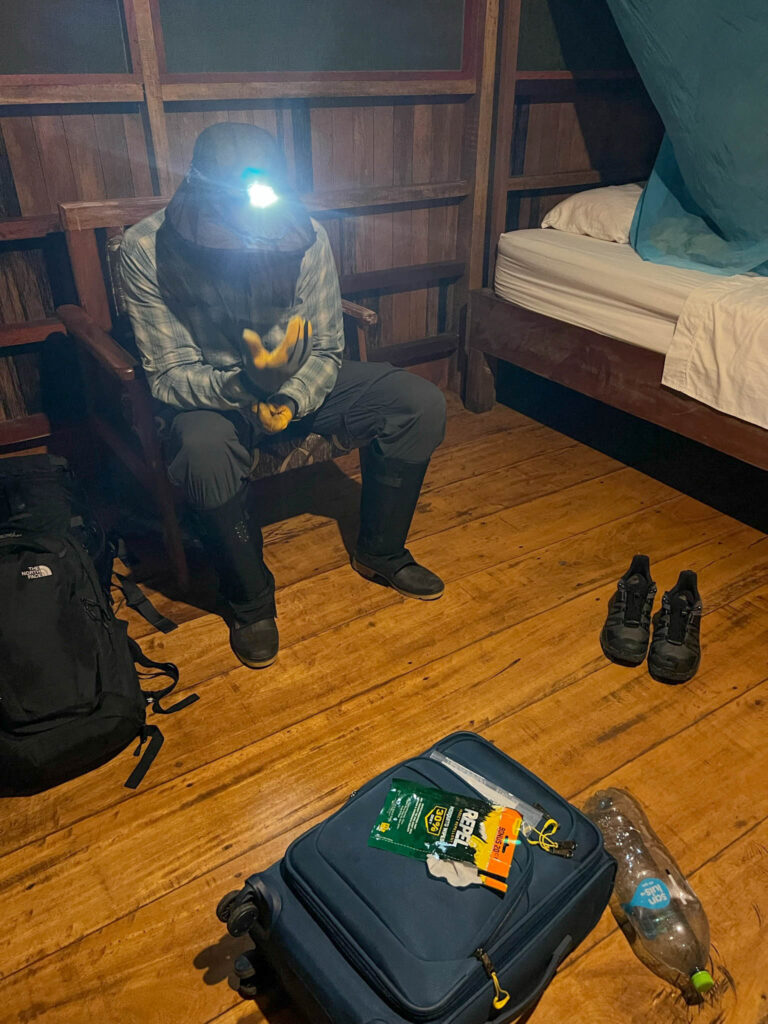
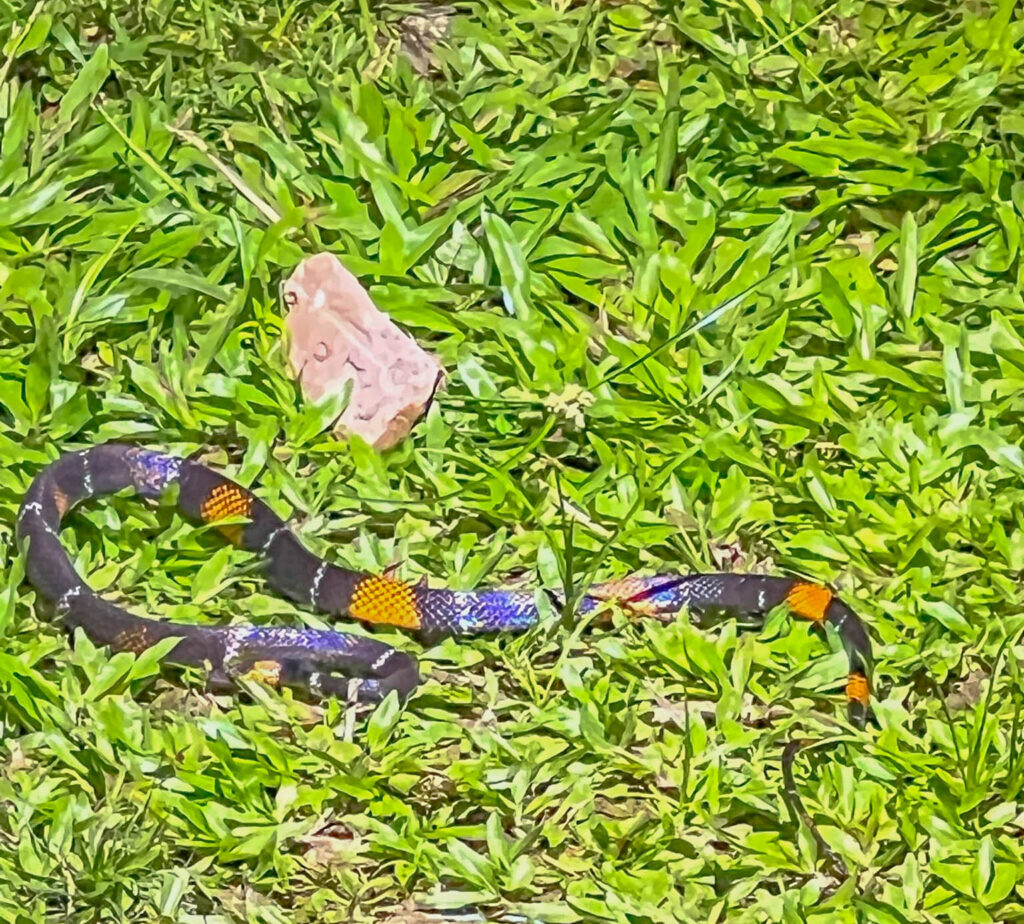

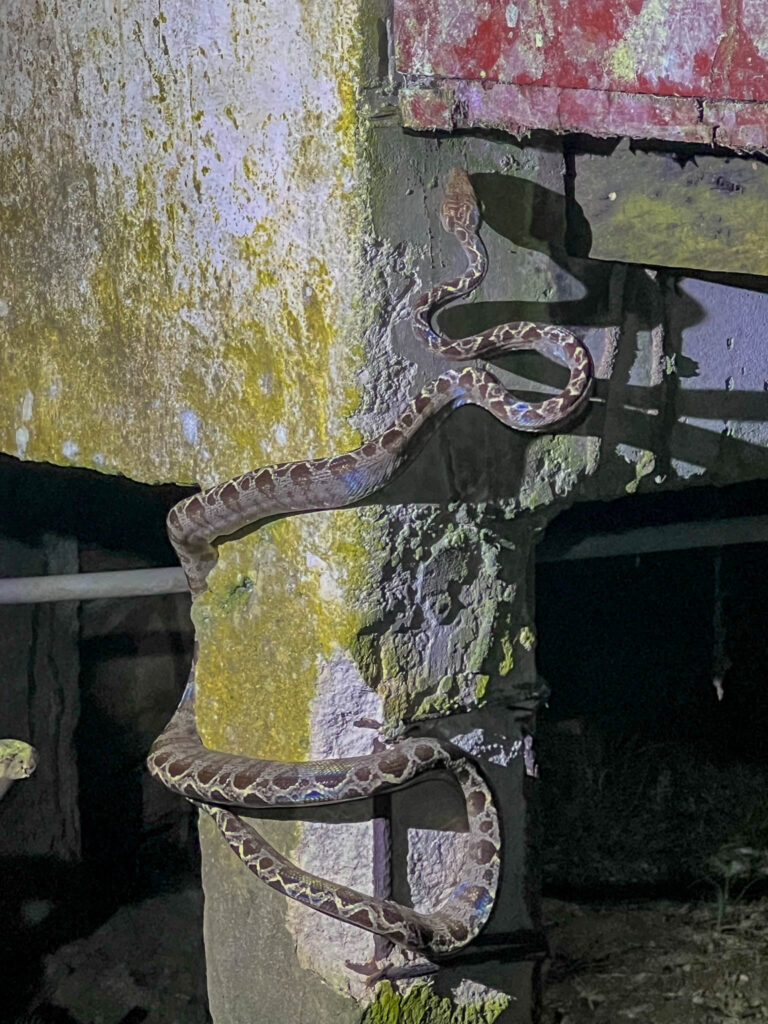
Catching a caiman, by hand
Our caiman nighttime excursion was fantastic, and a welcome break from the on-land nighttime escapades. It involved taking our canoe out to an area where caimans like to hang out. A caiman is similar to an alligator, but it has several distinct physical characteristics that put them in a different subfamily of the alligator family.
As we entered the caiman hangout by canoe, we were surrounded by an incredible chorus of frogs, insects, and other nighttime sounds.
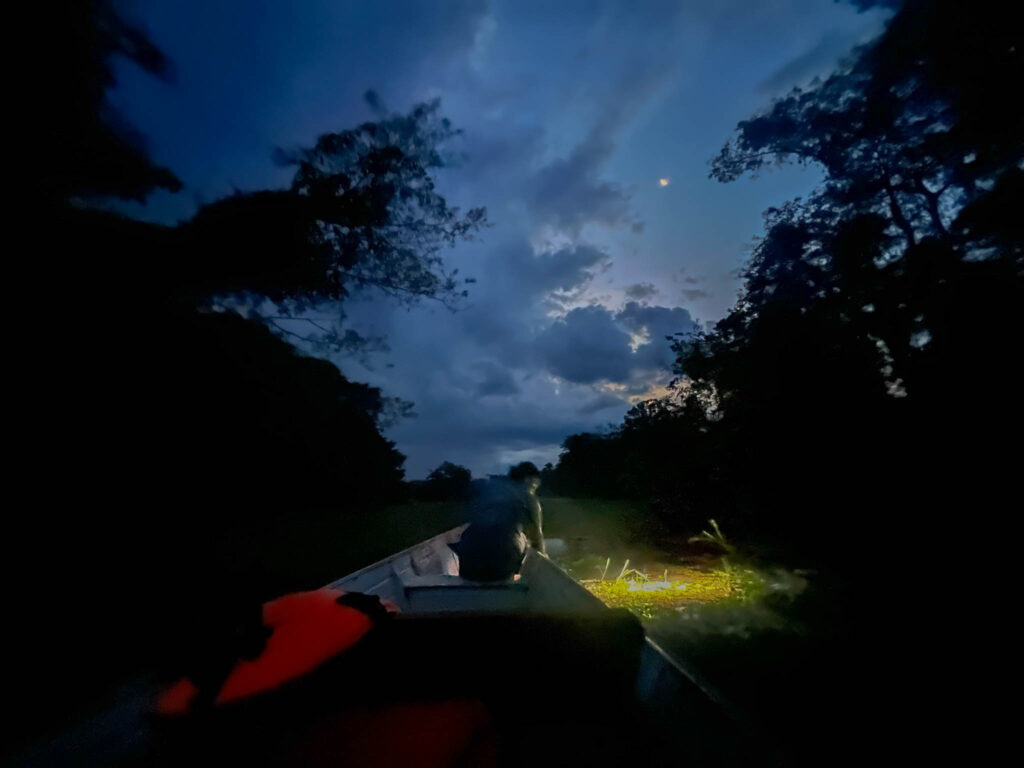
That moment, where were were surrounded by a very loud chorus of wildlife, was one of the highlights of the trip for me. It was amazing. It’s hard to capture, but here’s a sample of the audio:
Eventually, we got to a place where our guide spotted a caiman in his headlamp. The next thing I knew, Machete Mike turned on the engine full throttle while Eddie laid down on his belly on the front of the boat with his arms extended like superman, reaching out towards the surface of the water. Mike stopped the boat and, a few seconds later, my son and I were shocked to see Eddie stand up in the boat with a small caiman in his hands. It was pretty amazing. He gave my son an opportunity to hold the caiman for a photo.

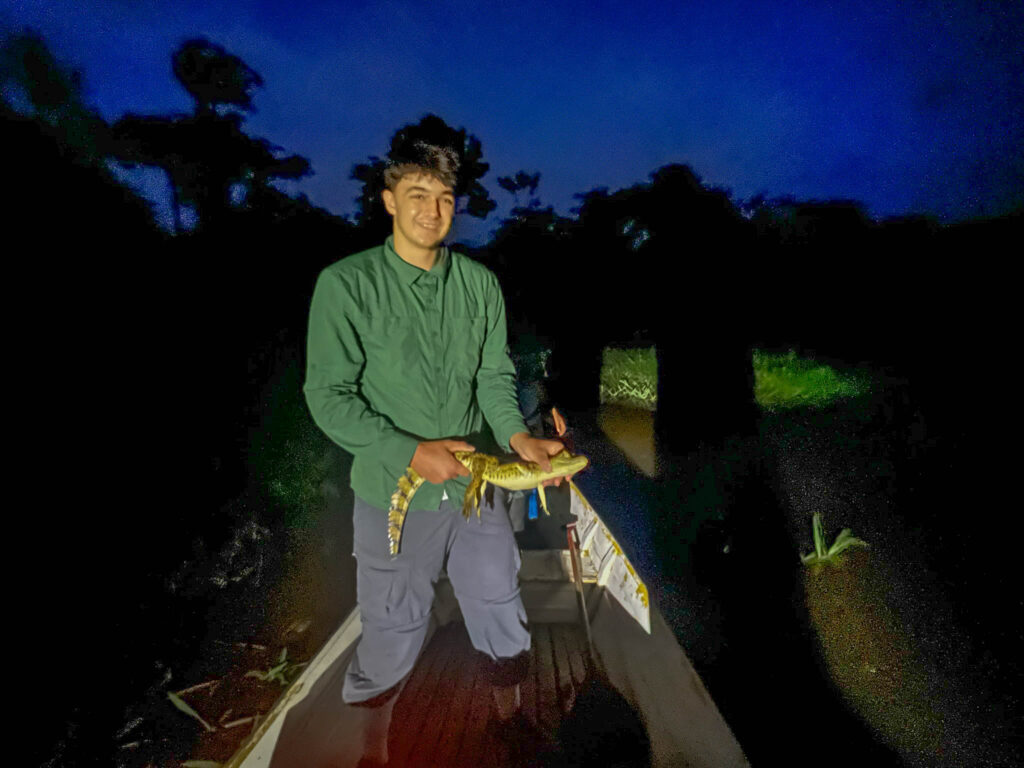
OMG, the spiders
I’m not a fan of being near spiders. Particularly big ones. Don’t get me wrong, I appreciate spiders, I just don’t want them on me. With that background, you can probably imagine how I felt walking through the jungle at night, with gigantic spiders running around all over the place. In hindsight, I can see why the boat captain ignored the baby spider colony next to his head on the boat. Out in the jungle, the spiders are huge and fast.
When we arrived, we noticed a spider exoskeleton hanging from a plant after a molt. Given the size of the exoskeleton, it got my attention.
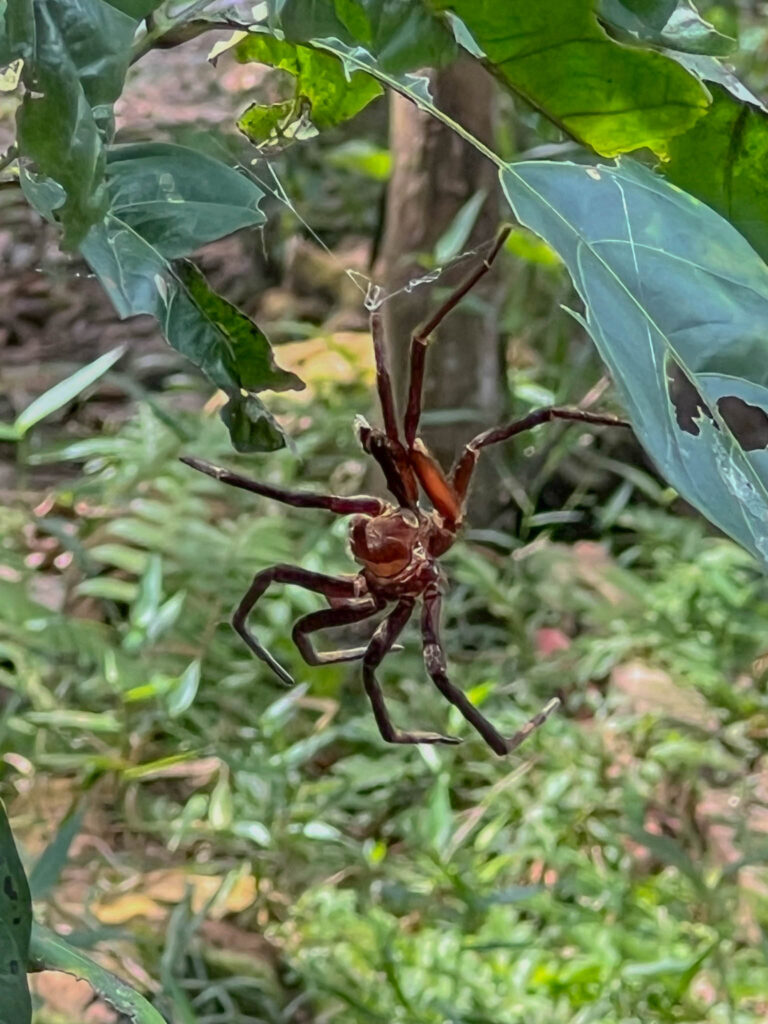
Before our first nighttime excursion, my son was leaning towards not putting on all of his gear, such as gloves, hat, and mosquito netting. However, that sentiment quickly changed due to an incident before dinner. We were supposed to take our shoes off before entering the dining area, so I put my hand against the outside wall as I removed my boots. When I stepped inside the dining area, my son greeted me wide-eyed, saying something along the lines of “Whoa!” or “Oh My God!”, or a combination of both. He was looking directly at me or, more accurately, my chest. This didn’t give me warm fuzzy feelings.
I instinctively jumped back and tugged on the front of my shirt in an attempt to dislodge whatever monster was on me. Thankfully, my efforts caused a huge wandering spider, the size of my hand, to suddenly fall to the floor before I had a chance to actually see it crawling on me. My son said it was starting to crawl from my chest towards my head. That wouldn’t have ended well for me. Thankfully, it was now on the ground and no longer a concern. The kitchen staff thought it was hilarious and one of the women came out with a dustpan and broom to sweep it up and put it outside like it was a cute little ladybug.
My son knows that having a spider like that crawling on me is the stuff of my nightmares, so this event proved to be one of the trip highlights for my son, and I have to agree. It was hilarious. We kept laughing and recounting that series of events, half due to shock and half due to concern for what we were about to experience once we started trekking through the jungle at night. We assumed that it must have quickly climbed or jumped on me when I’d put my hand against the wall outside. After dinner, my son and I immediately went back to our room to put on our full gear, no questions asked, with a smile and a sense of relief that we brought it with us on the trip.
Unfortunately, I didn’t get a clear photo of the wandering spider before the kitchen staff removed it, but we later saw a similar spider outside to give you a sense of what was crawling on my chest.
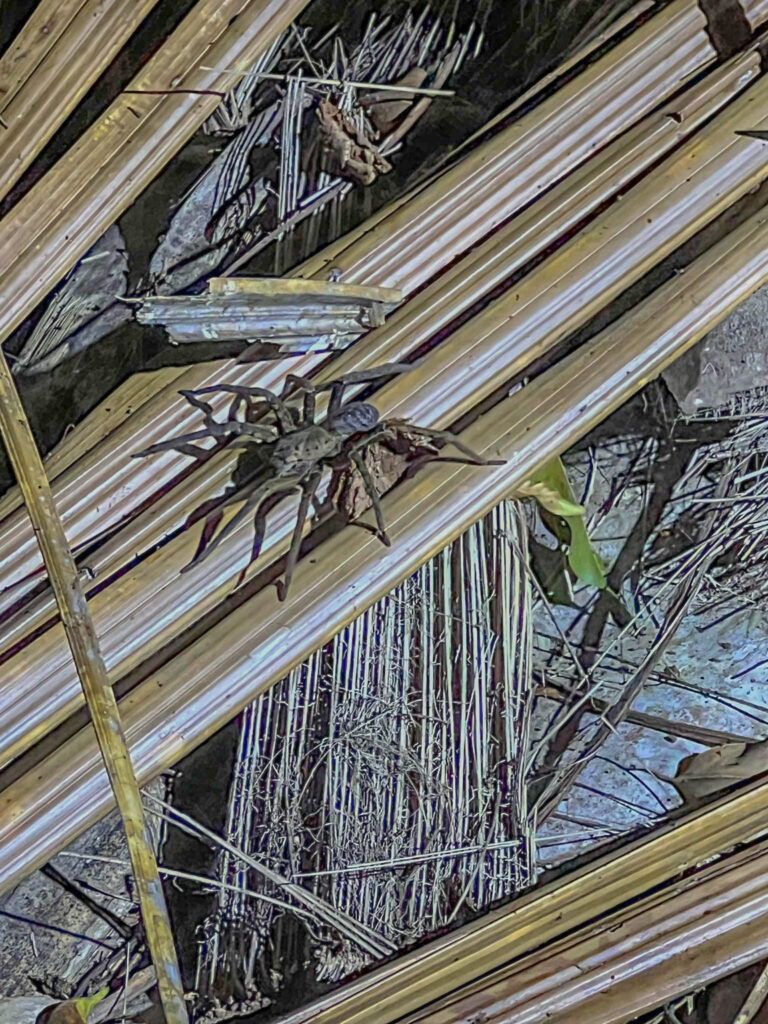

Here are some of the other wonderful and frightening spiders we encountered.
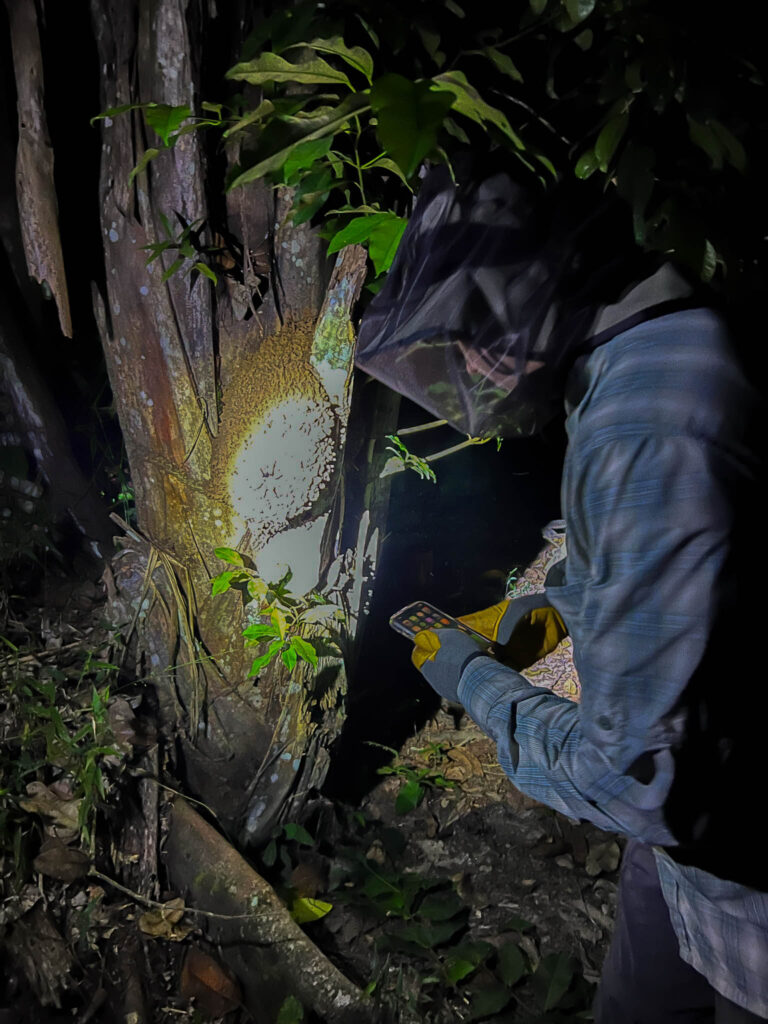
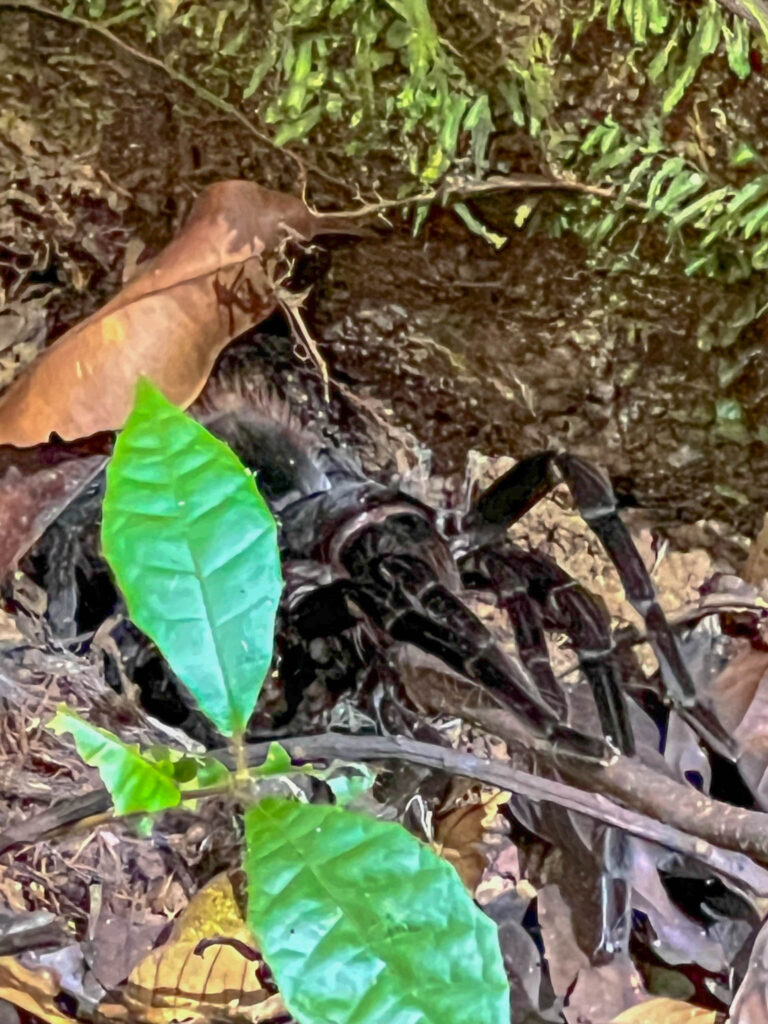
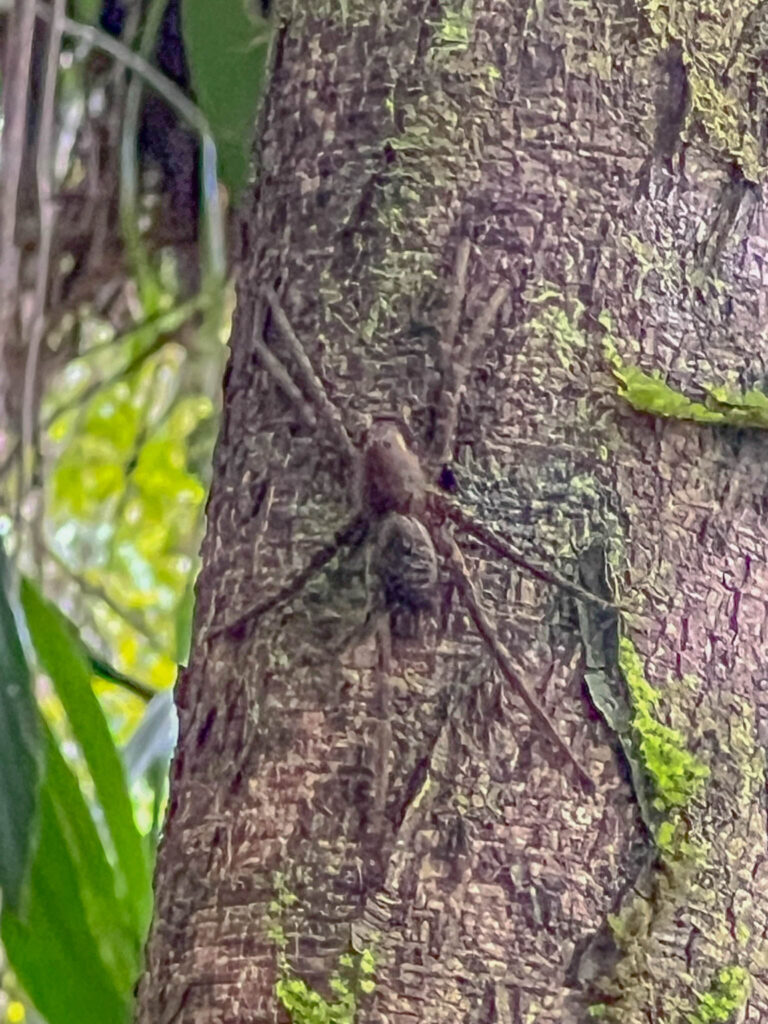
The adventure comes to an end
After 4 days and 3 nights, our jungle adventure came to an end, much to our relief. We both were very happy that we made the effort to go to the jungle, but we were also very glad it was over. Having said that, we both felt it was the right length of time for us – not too long and not too short. It was an unforgettable experience that included the most intense wildlife encounters we’ve ever had. As a souvenir, I walked away with at least 40 bug bites, mostly on my legs and ankles. But it was all worth it.
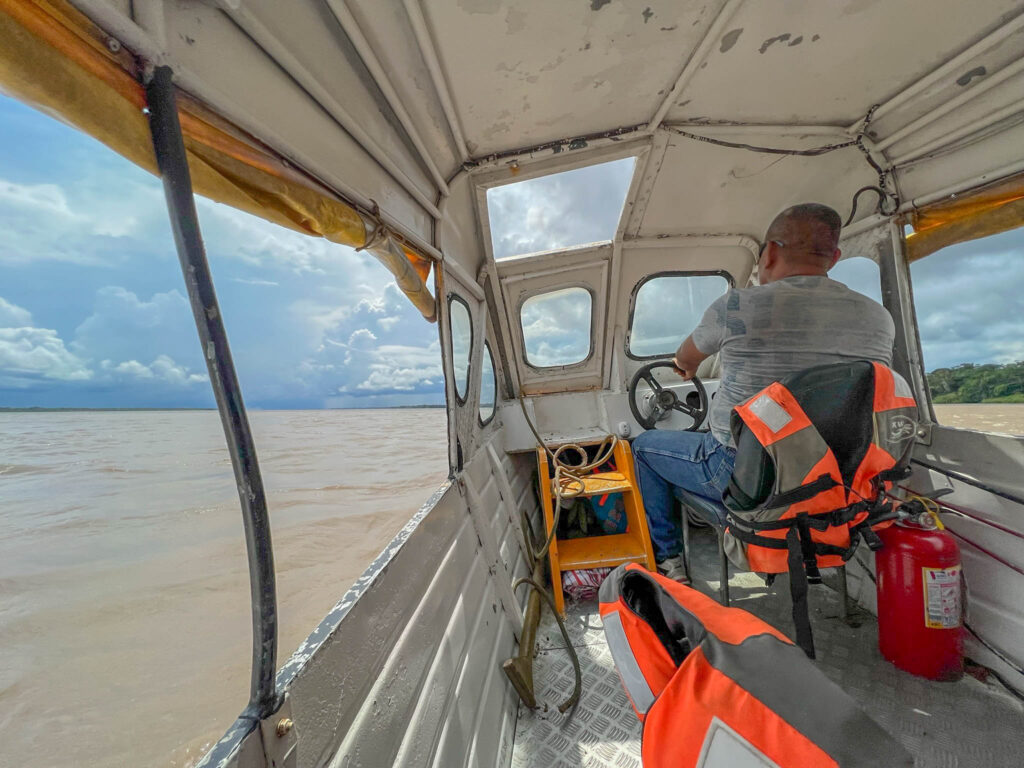
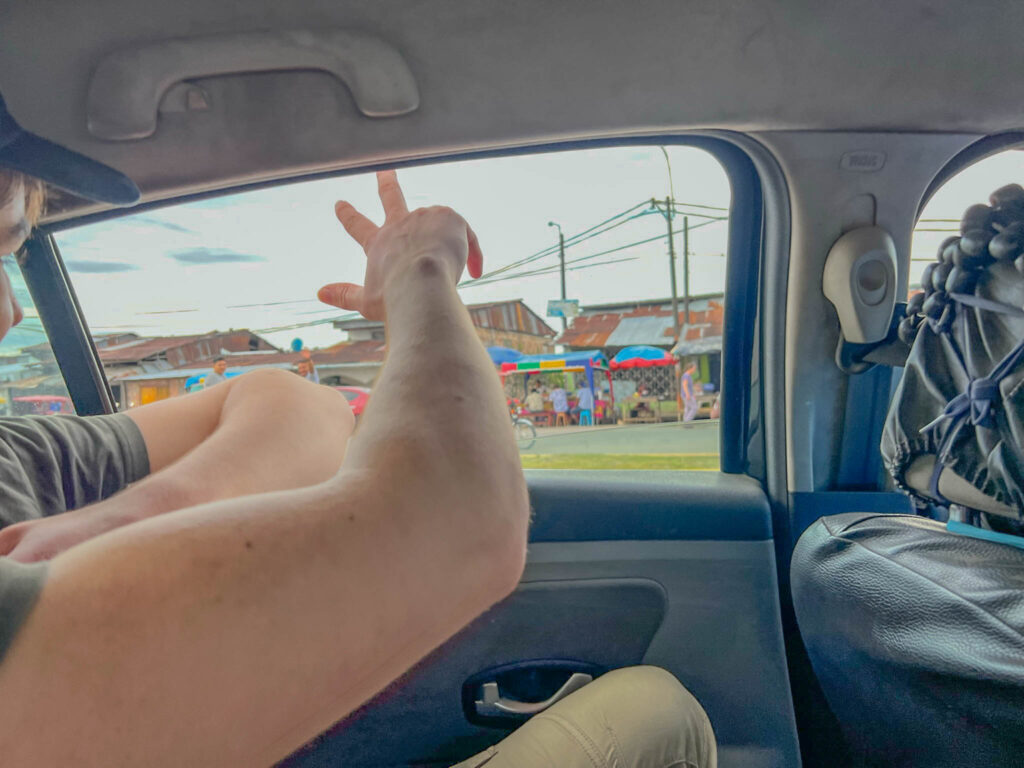
Thought for the Week
This week’s quote is from Jawaharlal Nehru, an associate of Mahatmi Gandhi, who I featured in my last post’s “Thought for the week”. It’s a good reminder that we don’t have to travel far to find adventure. Many of the best adventures can be found in our own backyard. We just need to keep our eyes and ears open and seek it out.
“We live in a wonderful world that is full of beauty, charm, and adventure. There is no end to the adventures that we can have if only we seek them with our eyes open.”
— Jawaharlal Nehru
Thanks for reading and happy travels!
Mark (The New Mexico Travel Guy)
Mark Aspelin, The New Mexico Travel Guy (www.newmexicotravelguy.com), is a travel writer and author of two books who has enjoyed a wide variety of adventures in his travels to over 100 countries and all 50 U.S. States. His current project involves visiting EVERY town in his home state of New Mexico (there’s over 500 towns) and writing a story about each one. When not traveling, Mark lives as a recluse in the mountains outside of Albuquerque, New Mexico.



